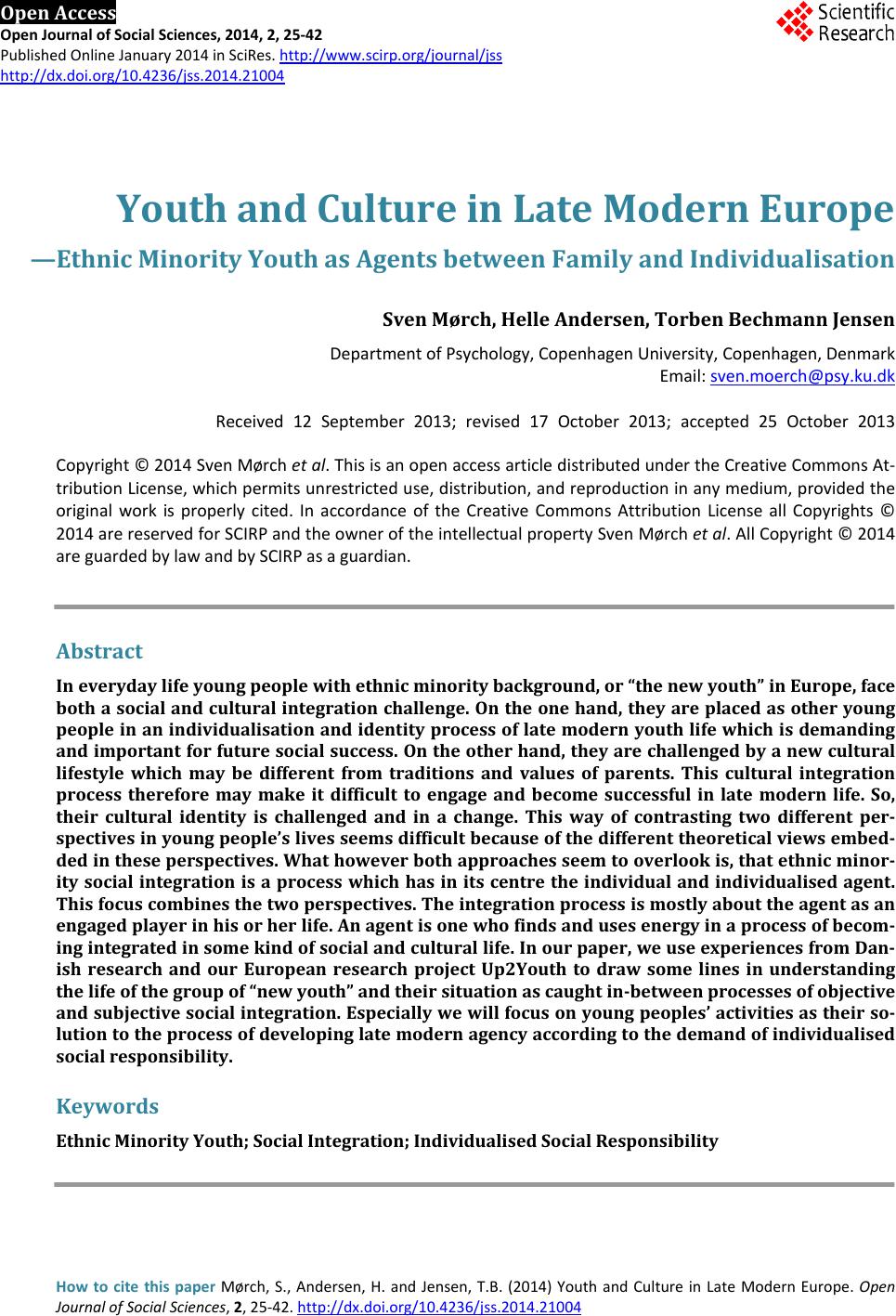 Open Access Open Journal of Social Sciences, 2014, 2, 25-42 Published Online January 2014 in SciRes. http://www.scirp.org/journal/jss http://dx.doi.org/10.4236/jss.2014.21004 Youth and Culture in Late Modern Europe —Ethnic Minority Youth as Agents between Family and Individualisation Sven Mørch, Helle Andersen, Torben Bechmann Jensen Department of Psychology, Copenhagen University, Copenhagen, Denmark Email: sven.moerch@psy.ku.dk Received 12 September 2013; revised 17 October 2013; accepted 25 October 2013 Copyright © 2014 Sven Mørch et al. This is an open access article distributed under the Creative Commons At- tribution License, which permits unrestricted use, distribution, and reproduction in any medium, provided the original work is properly cited. In accordance of the Creative Commons Attribution License all Copyrights © 2014 are reserved for SCIRP and the owner of the intellectual property Sven Mørch et al. All Copyright © 2014 are guarded by law and by SCIRP as a guardian. Abstract In everyday life young people with ethnic minority background, or “the new youth” in Europe, face both a social and cultural integration challenge. On the one hand, they are placed as other young people in an individualisation and identity process of late modern youth life which is demanding and important for future social success. On the other hand, they are challenged by a new cultural lifestyle which may be different from traditions and values of parents. This cultural integration process therefore may make it difficult to engage and become successful in late modern life. So, their cultural identity is challenged and in a change. This way of contrasting two different per- spectives in young people’s lives seems difficult because of the different theoretical views embed- ded in these perspectives. What however both approaches seem to overlook is, that ethnic minor- ity social integration is a process which has in its centre the individual and individualised agent. This focus combines the two perspectives. The integration process is mostly about the agent as an engaged player in his or her life. An agent is one who finds and uses energy in a process of becom- ing integrated in some kind of social and cultural life. In our paper, we use experiences from Dan- ish research and our European research project Up2Youth to draw some lines in understanding the life of the group of “new youth” and their situation as caught in-between processes of objective and subjective social integration. Especially we will focus on young peoples’ activities as their so- lution to the process of developing late modern agency according to the demand of individualised social responsibility. Keywords Ethnic Minority Youth; Social Integration; Individualised Social Responsibility How to cite this paper Mørch, S., Andersen, H. and Jensen, T.B. (2014) Youth and Culture in Late Modern Europe. Open Journal of Social Sciences, 2, 25-42. http://dx.doi.org/10.4236/jss.2014.21004 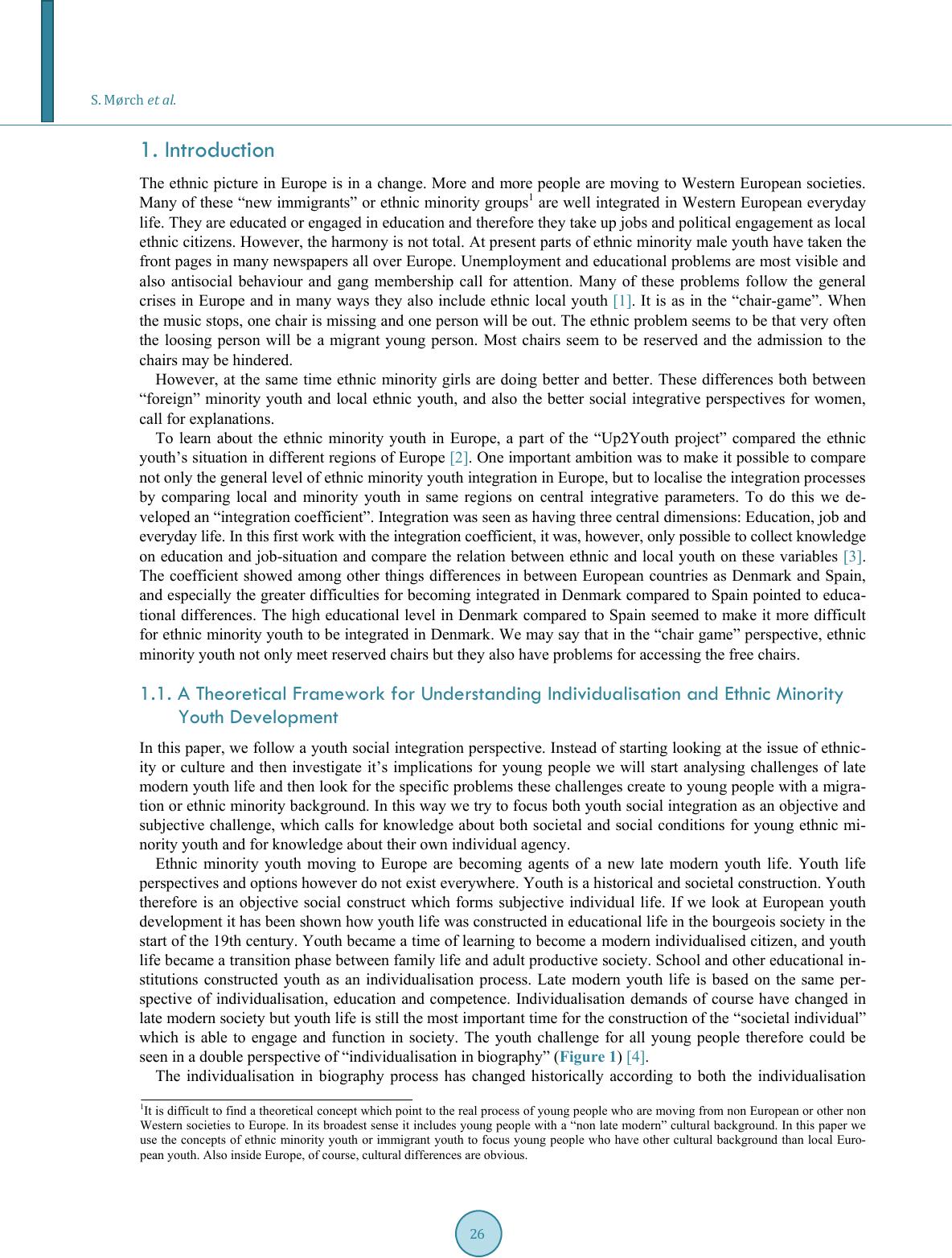 S. Mørch et al. 1. Introduction The ethnic picture in Europe is in a change. More and more people are moving to Western European societies. Many of these “new immigrants” or ethnic minority groups1 are well integrated in Western European everyday life. They are educated or engaged in education and therefore they take up jobs and political engagement as local ethnic citizens. However, th e harmony is not total. At present p arts of ethnic minority male youth have taken the front pages in many newspapers all over Europe. Unemployment and educational problems are most visible and also antisocial behaviour and gang membership call for attention. Many of these problems follow the general crises in Europe and in many ways they also include ethnic local youth [1]. It is as in the “chair-game”. When the music stops, one chair is missing and one person will be out. The ethnic problem seems to be that very often the loosing person will be a migrant young person. Most chairs seem to be reserved and the admission to the chairs may be hindered. However, at the same time ethnic minority girls are doing better and better. These differences both between “foreign” minority youth and local ethnic youth, and also the better social integrative perspectives for women, call for explanations. To learn about the ethnic minority youth in Europe, a part of the “Up2Youth project” compared the ethnic youth’s situation in different regions of Europe [2]. One important ambition was to make it possible to compare not only the general level of ethnic minority youth integration in Europe, but to localise the integration processes by comparing local and minority youth in same regions on central integrative parameters. To do this we de- veloped an “integration coefficient ”. Integration was seen as having three central dimensions: Education, job and everyday life . In this first work with the int e gration coeffic ient, it was, however, onl y possible to collect knowledge on education and job-situation and compare the relation between ethnic and local youth on these variables [3]. The coefficient showed among other things differences in between European countries as Denmark and Spain, and especially the greater difficulties for becoming integrated in Denmark compared to Spain pointed to educa- tional differences. The high educational level in Denmark compared to Spain seemed to make it more difficult for ethnic minority youth to be integrated in Denmark. We may say that in the “chair game” perspective, ethnic minority youth not only meet reserved chairs but they also have problems for accessing the free chairs. 1.1. A Theoretical Framework for Understanding Individualisation and Ethnic Minority Youth Development In this paper, we follow a youth social integration perspective. Instead of starting looking at the issue of ethnic - ity or culture and then investigate it’s implications for young people we will start analysing challenges of late modern youth life and then look for the specific problems these challenges create to young people with a migra- tion or ethnic minor ity background. In th is way we try to focus both youth social integration as an objective and subjective challenge, which calls for knowledge about both societal and social conditions for young ethnic mi- nority youth and for knowledge about their own ind ividual agency. Ethnic minority youth moving to Europe are becoming agents of a new late modern youth life. Youth life perspectives and options however do not exist everywhere. Youth is a historical and societal construction. Youth therefore is an objective social construct which forms subjective individual life. If we look at European youth development it has been shown how youth life was constructed in educational life in the bourgeois society in the start of the 19th century. Youth became a time of learning to become a modern individualised citizen, and youth life became a transition phase between family life and adult productive society. School and other educational in- stitutions constructed youth as an individualisation process. Late modern youth life is based on the same per- spective of individualisation, education and competence. Individualisation demands of course have changed in late modern society but youth life is still the most important time for the construction of the “societal individua l” which is able to engage and function in society. The youth challenge for all young people therefore could be seen in a double perspective of “individualisation in biography” (Figure 1) [4]. The individualisation in biography process has changed historically according to both the individualisation 1It is difficult to find a theoretical concept which point to th e real process of young people who are moving from non Western societies to Europe. In its broad est sense it includes you ng people with a “ non late modern” cultural background. In use the concepts of ethnic minority youth or immigrant youth to focus young people who have other cultural background than local Euro- pean youth. Also inside Europe, of course, cultural differences are obvious. 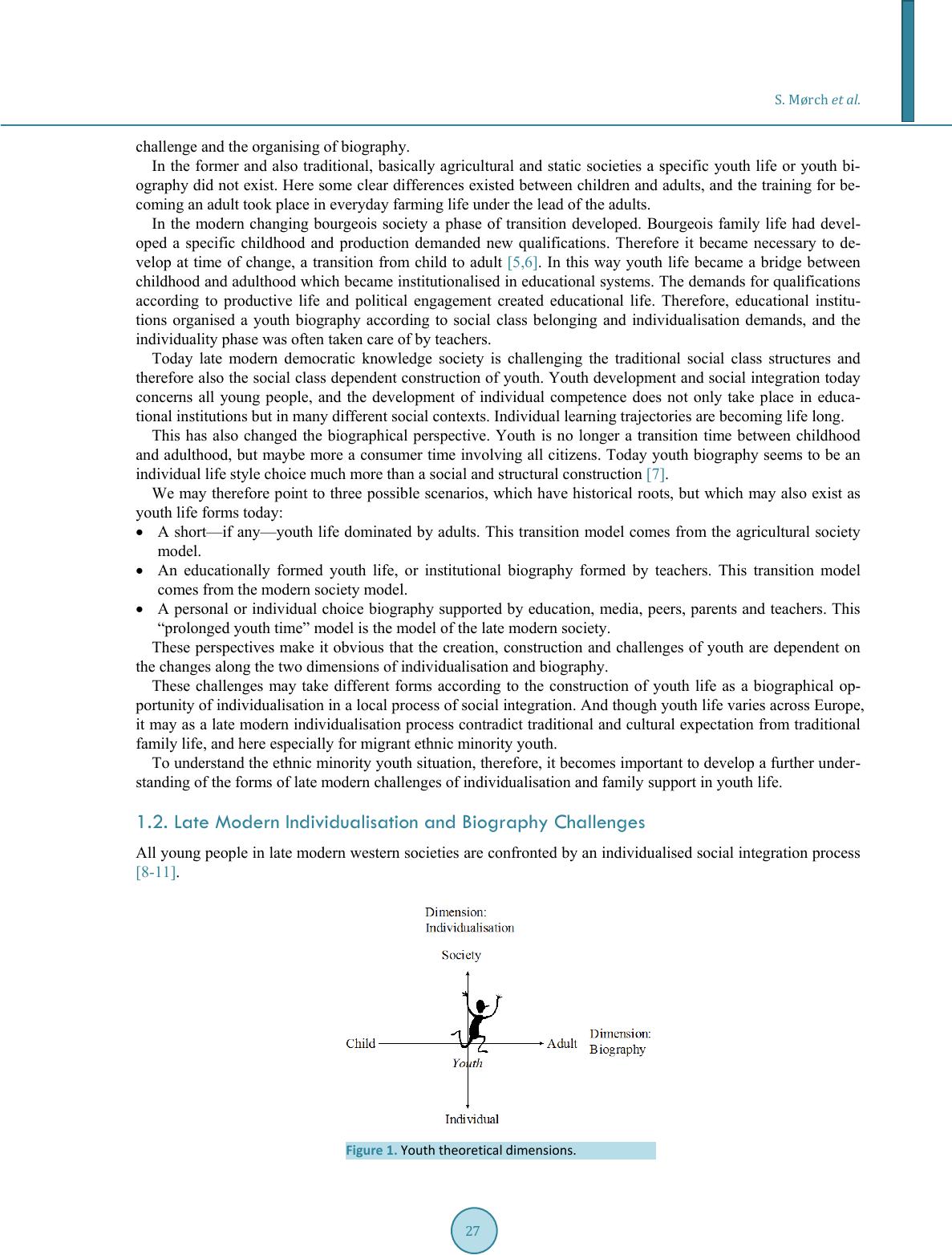 S. Mørch et al. challenge and the organising of biography. In the former and also traditional, basically agricultural and static societies a specific youth life or youth bi- ography did not exist. Here some clear differences existed between children and adults, and the training for be- coming an adult took place in everyday farming life under the lead of the adults. In the modern changing bourgeois society a phase of transition developed. Bourgeois family life had devel- oped a specific childhood and production demanded new qualifications. Therefore it became necessary to de- velop at time of change, a transition from child to adult [5,6]. In this way youth life became a bridge between childhood and adulthood which became institutionalised in educational systems. The demands for qualifications according to productive life and political engagement created educational life. Therefore, educational institu- tions organised a youth biography according to social class belonging and individualisation demands, and the individuality phase was often taken care of by teachers. Today late modern democratic knowledge society is challenging the traditional social class structures and therefore also the social class dependent construction of youth. Youth development and social integration today concerns all young people, and the development of individual competence does not only take place in educa- tional institutions but in many different social con texts. Ind ividua l learn ing trajectories are becoming life long. This has also changed the biographical perspective. Youth is no longer a transition time between childhood and adulthood, but maybe more a consumer time involving all citizens. Today youth biography seems to be an individual life style choice much more than a social and structural con s truction [7]. We may therefore point to three possible scenarios, which have historical roots, but which may also exist as youth life forms tod a y: • A short—if any—youth life dominated by adults. This transition model comes from the agricultural society model. • An educationally formed youth life, or institutional biography formed by teachers. This transition model comes from the modern society model. • A personal or individual choice biography supported by education, media, peers, parents and teachers. This “prolonged youth time” model is the model of the late modern society. These perspectives make it obvious that the creation, construction and challenges of youth are dependent on the changes along the two dimensions of individualisation and biography. These challenges may take different forms according to the construction of youth life as a biographical op- portunity of individualisation in a local process of social integration. And though youth life varies across Europe, it may as a late modern individualisation process contrad ict traditional and cultural expectation from traditional family life, and here especially for migrant ethnic minority youth. To understand the ethnic minority youth situation, therefore, it becomes important to develop a further under- standing of the forms of late modern challenges of individualisation and family support in youth life. 1.2. Late Modern Individualisation and Biography Challenges All young people in late modern western societies are confronted b y an individualised social integration process [8-11]. Figure 1. Youth theoretical dimensions. 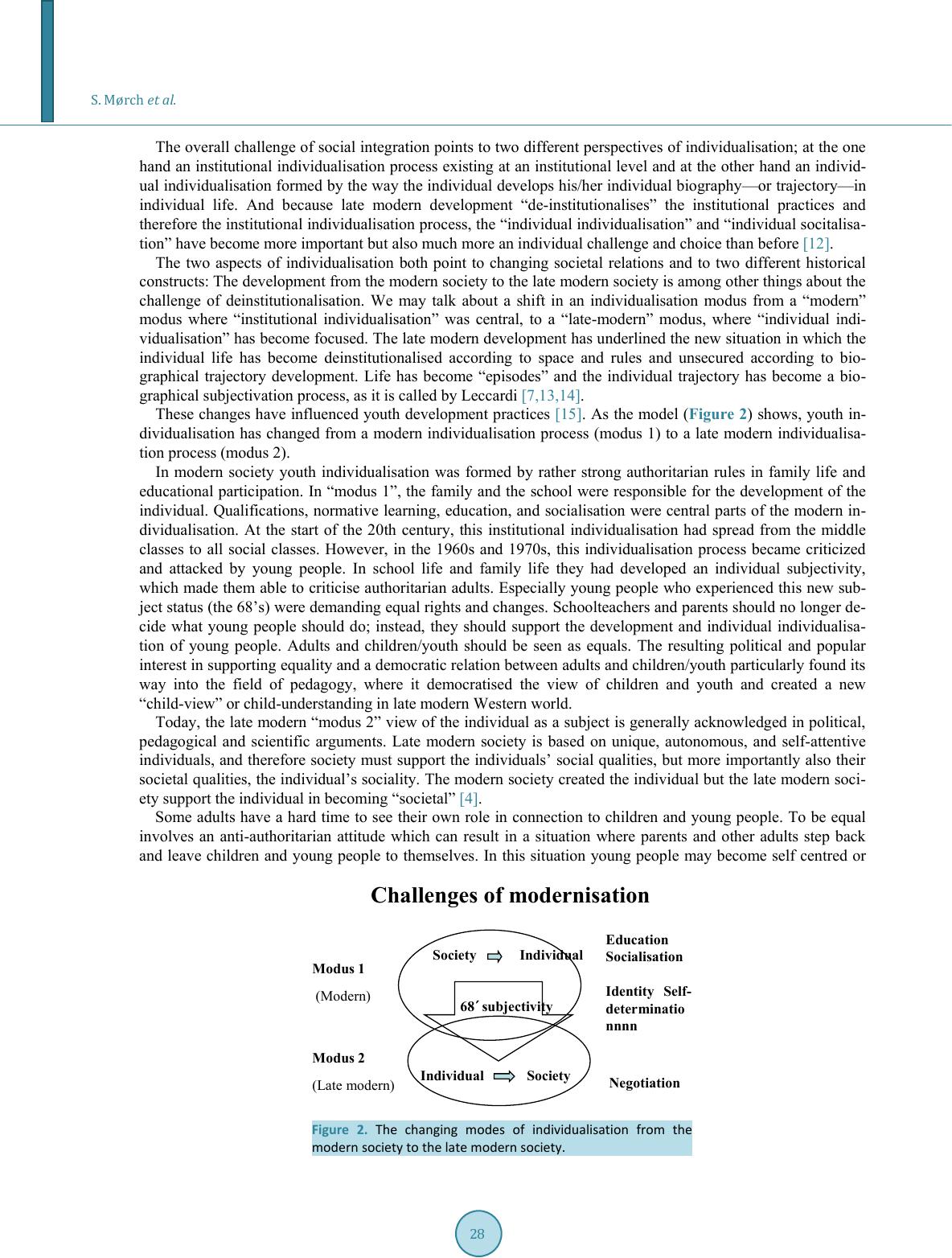 S. Mørch et al. The overall challenge of so cial integration points to two different perspectives of individualisation; at the one hand an institutional individualisation process existing at an institutional level and at the other hand an individ- ual individualisation formed by the way the individual develops his/her individual biography—or trajectory—in individual life. And because late modern development “de-institutionalises” the institutional practices and therefore the institution al individualisation process, the “individual individu alisation” and “individual socitalisa - tion” have become more important but also much more an individual challenge and choice than b ef ore [12]. The two aspects of individualisation both point to changing societal relations and to two different historical constructs: The development from the modern society to the late modern society is among other things about the challenge of deinstitutionalisation. We may talk about a shift in an individualisation modus from a “modern” modus where “institutional individualisation” was central, to a “late-modern” modus, where “individual indi- vidualisation” has become focused. The late modern development has underlined the new situation in which the individual life has become deinstitutionalised according to space and rules and unsecured according to bio- graphical trajectory development. Life has become “episodes” and the individual trajectory has become a bio- graphical subjectivation pro cess, as it is called by Leccardi [7,13, 14]. These changes have influenced youth development practices [15]. As the model (Figure 2) shows, youth in- dividualisation has changed from a modern individualisation process (modus 1) to a late modern individualisa- tion proce s s (modus 2) . In modern society youth individualisation was formed by rather strong authoritarian rules in family life and educational participation. In “modus 1”, the family and the school were responsible for the development of the individual. Qualification s, normative learning, education, and socialisation were central parts of the modern in- dividualisation. At the start of the 20th century, this institutional individualisation had spread from the middle classes to all social classes. However, in the 1960s and 1970s, this individualisation process became criticized and attacked by young people. In school life and family life they had developed an individual subjectivity, which made them able to criticise authoritarian adults. Especially young people who experienced this new sub- ject status (the 68’s) were demanding equal rights and changes. Schoolteachers and parents should no longer de- cide what young people should do; instead, they should support the development and individual individualisa- tion of young people. Adults and children/youth should be seen as equals. The resulting political and popular interest in supporting equ ality and a democratic relatio n between adults and children /youth particularly found its way into the field of pedagogy, where it democratised the view of children and youth and created a new “child-view” or child-understandi ng in late modern Wes t e rn world . Today, the late modern “modus 2” view of the individual as a subject is generally acknowledged in political, pedagogical and scientific arguments. Late modern society is based on unique, autonomous, and self-attentive individuals, and therefore society must support the individuals’ social qualities, but more importantly also their societal qualities, the individual’s sociality. The modern society created the individual but the late modern soci- ety support the individual in becoming “societal” [4]. Some adults have a hard time to see their own role in connection to children and young people. To be equal involves an anti-authoritarian attitude which can result in a situation where parents and other adults step back and leave children and young people to themselves. In this situation young people may become self centred or Figure 2. The changing modes of individualisation from the modern society to the late modern society. Society Individual Individual Society 68´subjectivity Modus 1 Modus 2 (Late modern) (Modern) Education Socialisatio n Identity Self- determinatio nnnn Negotiation Challenges of modernisation 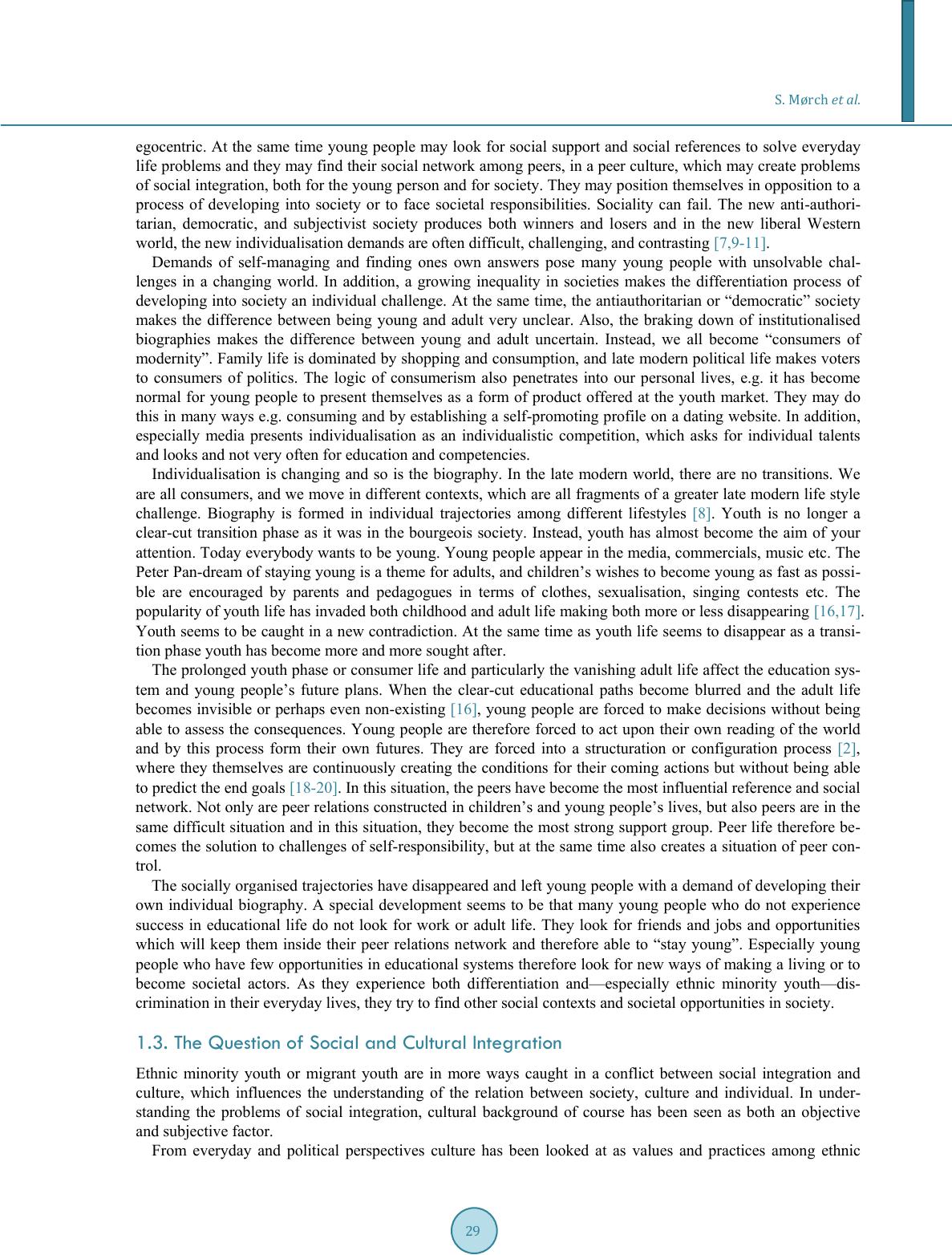 S. Mørch et al. egocentric. At the same time young people may look for social support and social references to solve everyday life problems and they may find their social network among peers, in a peer culture, which may create problems of social integration, both for the young person and for society. They may position themselves in opposition to a process of developing into society or to face societal responsibilities. Sociality can fail. The new anti-authori- tarian, democratic, and subjectivist society produces both winners and losers and in the new liberal Western world, the new individualisation demands are often difficult, challenging, and contrasting [7,9-11]. Demands of self-managing and finding ones own answers pose many young people with unsolvable chal- lenges in a changing world. In addition, a growing inequality in societies makes the differentiation process of developing into society an individua l challenge. At the same time, the antiauthoritarian or “democratic” society makes the difference between being young and adult very unclear. Also, the braking down of institutionalised biographies makes the difference between young and adult uncertain. Instead, we all become “consumers of modernity”. F amily life is dominated by shopping and consu mption, and late modern political life makes voters to consumers of politics. The logic of consumerism also penetrates into our personal lives, e.g. it has become normal for young people to present themselves as a form of product offered at the youth market. They may do this in many ways e.g. consuming and by establishing a self-promoting profile on a dating website. In addition, especially media presents individualisation as an individualistic competition, which asks for individual talents and looks and not very often for educ a t ion and compete nc ies. Individualisation is changing and so is the biography. In the late modern world, there are no transitions. We are all consumers, and we move in different contexts, which are all fragments of a greater late modern life style challenge. Biography is formed in individual trajectories among different lifestyles [8]. Youth is no longer a clear-cut transition phase as it was in the bourgeois society. Instead, youth has almost become the aim of your attention. Today everybody wants to be young. Young people appear in the media, commercials, music etc. The Peter Pan-dream of staying young is a theme for adults, and children’s wishes to become young as fast as possi- ble are encouraged by parents and pedagogues in terms of clothes, sexualisation, singing contests etc. The popularity of youth life has invaded both childhood and adult life making both more or less disappearing [16,17 ]. Youth seems to be caught in a new contradiction. At the same time as youth life seems to disappear as a transi- tion phase youth has become more and more sought after. The prolonged youth phase or consumer life and particularly the vanishing adult life affect the education sys- tem and young people’s future plans. When the clear-cut educational paths become blurred and the adult life becomes invisible or perhaps even non-existing [16], young people are forced to make decisions without being able to assess the consequences. Young people are therefore forced to act upon their own reading of the world and by this process form their own futures. They are forced into a structuration or configuration process [2], where they themselves are continuously creating the conditions for their coming actions but without being able to predict the end goals [18-20]. In this situation, the peers have become the most influential reference and social network. Not only are peer relations constructed in children’s and young people’s lives, but also peers are in the same difficult situation and in this situation, they become the most strong support gro up. Peer life therefore be - comes the solution to challenges of self-responsibility, but at the same time also creates a situation of peer con- trol. The socially organised trajectories have disappeared and left young people with a demand of developing their own individual biography. A special development seems to be that many young people who do not experience success in educational life do not look for work or adult life. They look for friends and jobs and opportunities which will keep them inside their peer relations network and therefore able to “stay young”. Especially young people who have few opportunities in educational systems therefore look for new ways of making a living or to become societal actors. As they experience both differentiation and—especially ethnic minority youth—dis- crimination in their everyday lives, they try to find other social contexts and societal opportunities in society. 1.3. The Question of Social and Cultural Integration Ethnic minority youth or migrant youth are in more ways caught in a conflict between social integration and culture, which influences the understanding of the relation between society, culture and individual. In under- standing the problems of social integration, cultural background of course has been seen as both an objective and subjective factor. From everyday and political perspectives culture has been looked at as values and practices among ethnic 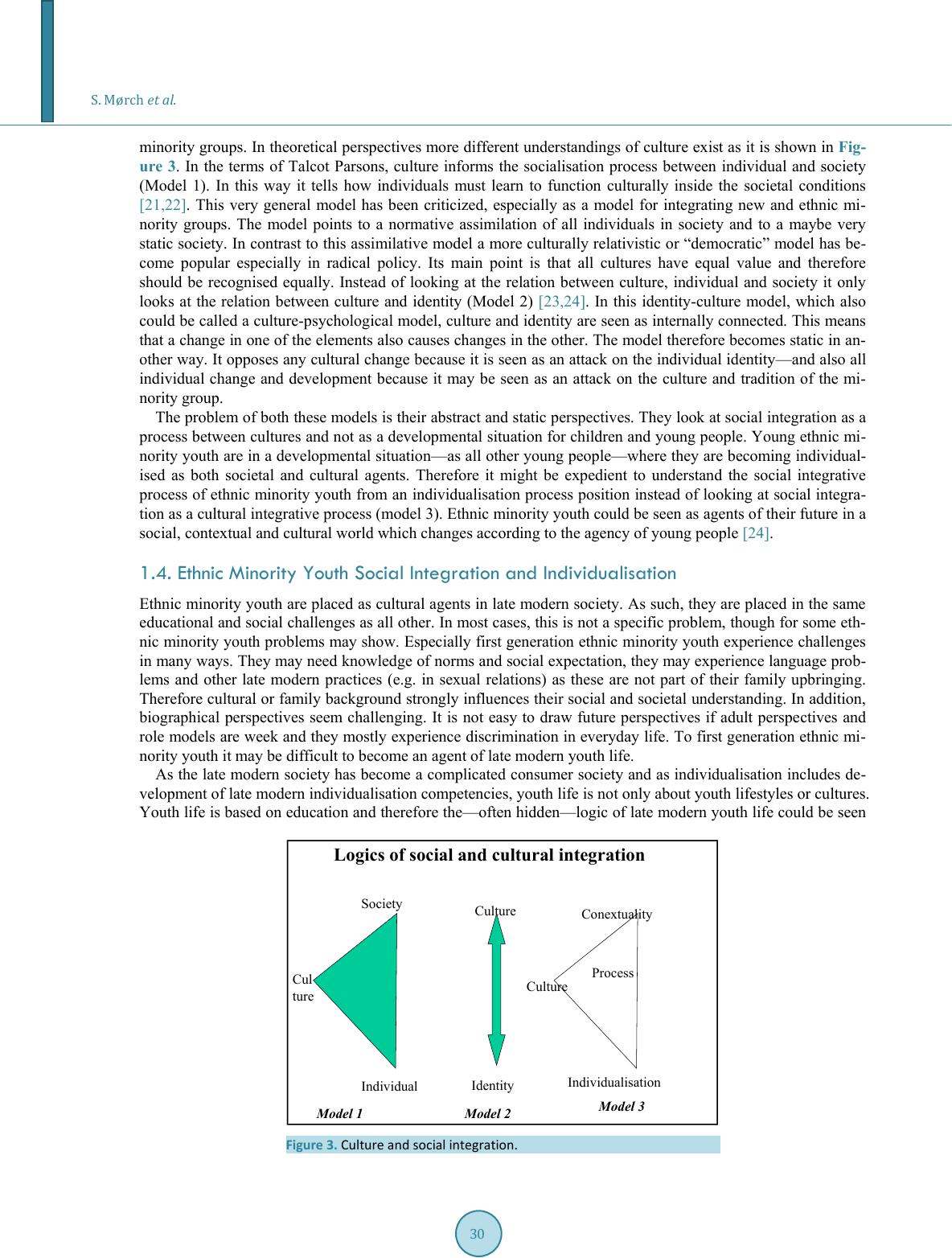 S. Mørch et al. minority groups. In theoretical perspectives more different understandings of culture exist as it is shown in Fig - ure 3. In the terms of Talcot Parsons, culture informs the socialisation process between individual and society (Model 1). In this way it tells how individuals must learn to function culturally inside the societal conditions [21,22]. This very general model has been criticized, especially as a model for integrating new and ethnic mi- nority groups. The model points to a normative assimilation of all individuals in society and to a maybe very static society. In contrast to this assi milative model a more culturally relativistic or “democratic” model has be- come popular especially in radical policy. Its main point is that all cultures have equal value and therefore should be recognised equally. Instead of looking at the relation between culture, individual and society it only looks at the relation between culture and identity (Model 2) [23,24]. In this identity-culture model, which also could be called a culture-psychological model, culture and identity are seen as internally connected. This means that a change in one of the elements also causes changes in the other. The model therefore becomes static in an- other way. It opposes any cultural change because it is seen as an attack on the individual identity —and also all individual change and development because it may be seen as an attack on the culture and tradition of the mi- nority group. The problem of both these models is their abstract and static perspectives. They look at social integration as a process between cultures and not as a developmental situation for children and young people. Young ethnic mi- nority youth are in a developmental situation —as all other young people—where they are becoming individual- ised as both societal and cultural agents. Therefore it might be expedient to understand the social integrative process of ethnic minority youth from an individualisation process position instead of looking at social integra- tion as a cultural integrative process (model 3). Ethnic minority youth could be seen as agents of their future in a social, contextual and cultural world which changes according to the agency of young people [24]. 1.4. Ethnic Minority Youth Social Integration and Individualisation Ethnic minority youth are placed as cultural agents in late modern society. As such, they are placed in the same educational and social challenges as all other. In most cases, this is not a specific problem, though for some eth- nic minority youth problems may show. Especially first generation ethnic minority youth experience challenges in many ways. They may need knowledge of norms and social expectation, they may experience language prob- lems and other late modern practices (e.g. in sexual relations) as these are not part of their family upbringing. Therefore cultural or family background strongly influences their social and societal understanding. In addition, biographical perspectives seem challenging. It is not easy to draw future perspectives if adult perspectives and role models are week and they mostly experience discrimination in everyday life. To first generation ethnic mi- nority youth it may be difficult to become an agent of late modern youth life. As the late modern society has become a complicated consumer society and as individualisation includes de- velopment of late modern individualisation competencies, youth life is not o nly about youth lifestyles or cultur e s. Youth life is based on education and therefore the—often hidden—logic of late modern youth life could be seen Figure 3. Culture and social integration. Logics of social and cultural integration Cul ture Society Individual Model 1 Identity Culture Individualisation Conextuality Culture Model 2Model 3 Process 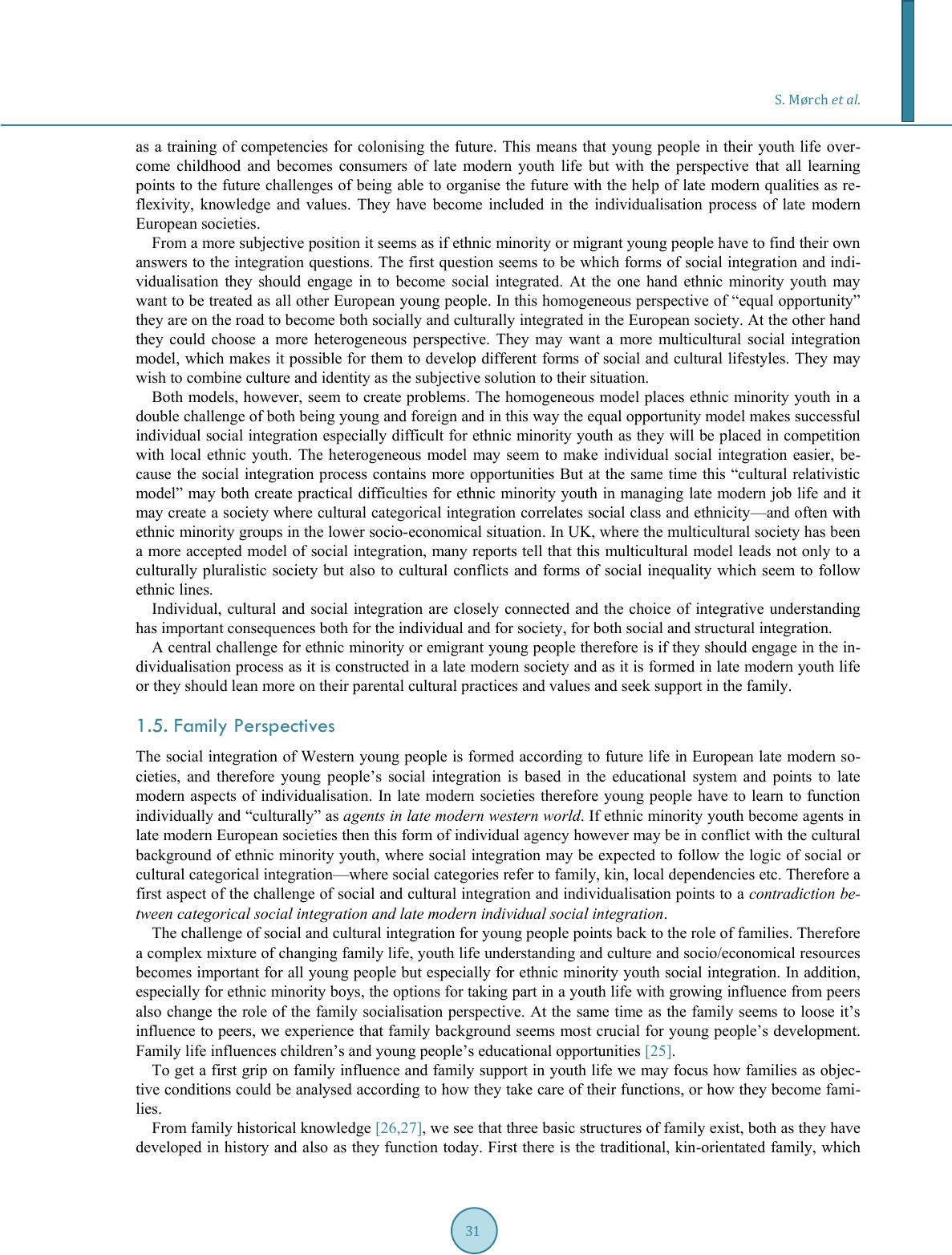 S. Mørch et al. as a training of competencies for colonising the future. This means that young people in their youth life over- come childhood and becomes consumers of late modern youth life but with the perspective that all learning points to the future challenges of being able to organise the future with the help of late modern qualities as re- flexivity, knowledge and values. They have become included in the individualisation process of late modern European societies. From a more subjective position it seems as if ethnic minority or migrant young people have to find their own answers to the integration questions. The first question seems to be which forms of social integration and indi- vidualisation they should engage in to become social integrated. At the one hand ethnic minority youth may want to be treated as all other European young people. In this homogeneous perspective of “equal opportunity” they are on the road to b ecome both socially and culturally integrated in the European society. At the other hand they could choose a more heterogeneous perspective. They may want a more multicultural social integration model, which makes it possible for them to develop different forms of social and cultural lifestyles. They may wish to combine culture and identity as the subjectiv e so lution to their situ ation. Both models, however, seem to create problems. The homogeneous model places ethnic minority youth in a double challenge of both being young and foreign and in this way the equal opportunity model makes successful individual social integration especially difficult for ethnic minority youth as they will be placed in competition with local ethnic youth. The heterogeneous model may seem to make individual social integration easier, be- cause the social integration process contains more opportunities But at the same time this “cultural relativistic model” may both create practical difficulties for ethnic minority youth in managing late modern job life and it may create a society where cultural categorical integration correlates social class and ethnicity —and often with ethnic minority groups in the lower socio-economical situation. In UK, where the multicultural society has been a more accepted model of social integration, many reports tell that this multicultural model leads not only to a culturally pluralistic society but also to cultural conflicts and forms of social inequality which seem to follow ethnic lines. Individual, cultural and social integration are closely connected and the choice of integrative understanding has important consequences both for the individual and for society, for both social and structural integration. A central challenge for ethnic minority or emigrant young people therefore is if they should engage in the in- dividualisation proc ess as it is constructed in a late modern society an d as it is formed in late modern youth life or they should lean more on their parental cultural practices and values and seek support in the family. 1.5. Family Perspectives The social integration of Western young people is formed according to future life in European late modern so- cieties, and therefore young people’s social integration is based in the educational system and points to late modern aspects of individualisation. In late modern societies therefore young people have to learn to function individually and “culturally” as agents in late modern western world. If ethnic minority youth become agents in late modern European societies then this form of individual agency however may be in conflict with the cultural background of ethnic minority youth, where social integration may be expected to follow the logic of social or cultural categorical integration —where social categories refer to family, kin, local dependencies etc. Therefore a first aspect of the ch allenge of social and cultural integration and individualisatio n points to a contradiction be- tween categorical social integration and late modern individual social integration. The challenge of social and cultural integration for young people points back to the role of families. Therefore a complex mixture of changing family life, youth life understanding and culture and socio/economical resources becomes important for all young people but especially for ethnic minority youth social integration. In addition, especially for ethnic minority boys, the options for taking part in a youth life with growing influence from peers also change the role of the family socialisation perspective. At the same time as the family seems to loose it’s influence to peers, we experience that family background seems most crucial for young people’s development. Family life influences children’s and young people’s educational opportunities [25]. To get a first grip on family influence and family support in youth life we may focus how families as objec- tive conditions could be analysed according to how they take care of their functions, or how they become fami- lies. From family historical knowledge [26,27], we see that three basic structures of family exist, both as they have developed in history and also as they function today. First there is the traditional, kin-orientated family, which 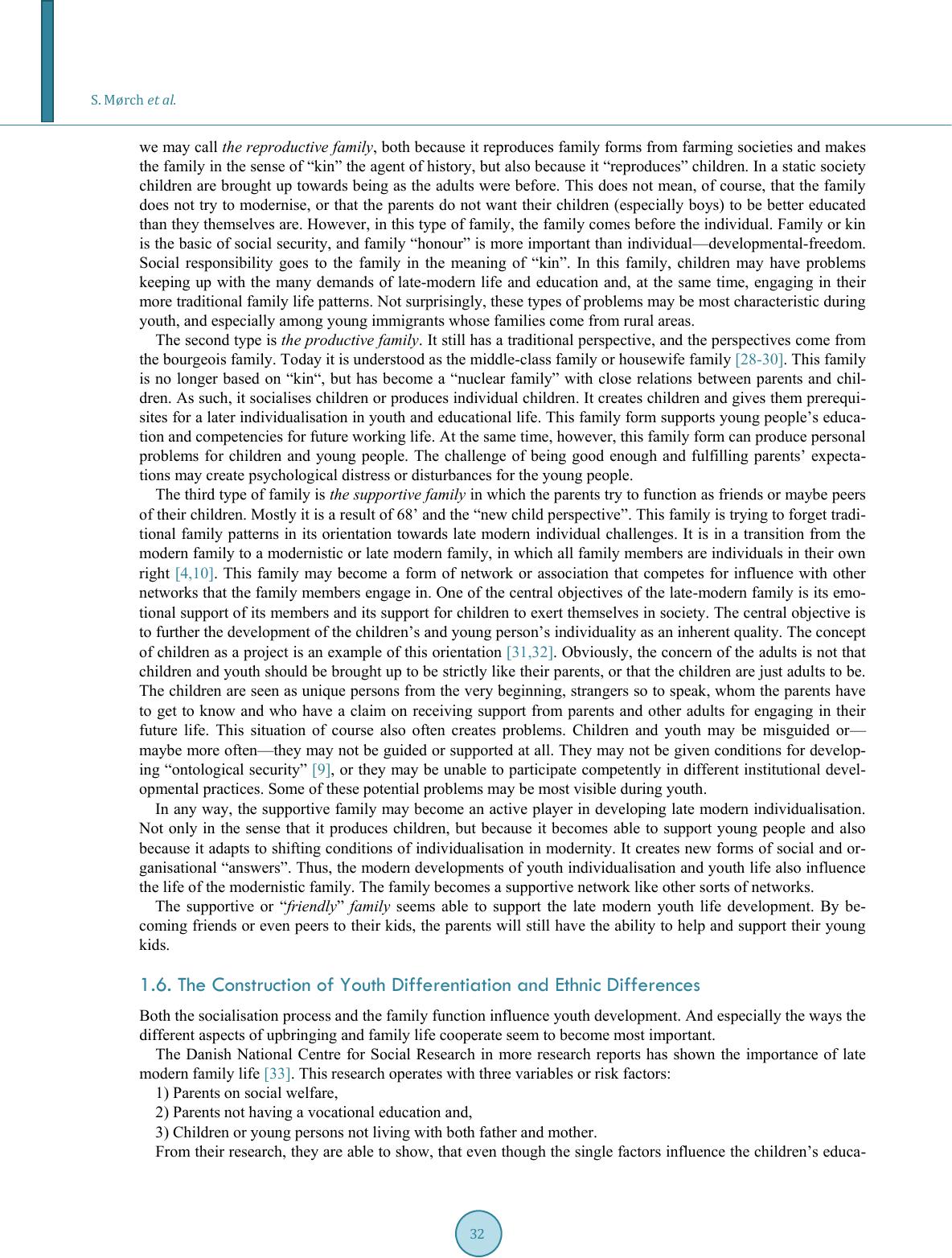 S. Mørch et al. we may call the reproductive family , both because it reproduces family forms from farming societies and makes the family in the sense of “kin” the agent of history, but also because it “reproduces” children. In a static society children are brought up towards being as the adults were before. This does not mean, of course, that the family does not try to modernise, or that the parents do not want their children (especially boys) to be better educated than they themselves are. However, in this type of family, the family comes before the individual. Family or kin is the basic of social security, and family “honour” is more important than individual—developmental-freedom. Social responsibility goes to the family in the meaning of “kin”. In this family, children may have problems keeping up with the many demands of late-modern life and education and, at the same time, engaging in their more traditional family life pattern s. No t surprisingly, th ese types o f problems may be most charac teristic during youth, and especially among young immigrants whose families come from rural areas. The second type is the productive family. I t still has a traditiona l perspective, and the persp ectives come from the bourgeois family. Today it is understood as the middle-class family or housewife family [28-30]. This family is no longer based on “kin“, but has become a “nuclear family” with close relations between parents and chil- dren. As such, it socialises children or produces individual children. It creates children and gives them prerequi- sites for a later individualisation in youth and educ ational life. This family fo rm supports young peop le’s educa - tion and competencies for future working life. At the same time, however, this family form can produce personal problems for children and young people. The challenge of being good enough and fulfilling parents’ expecta- tions may create psychological distress or disturbances for the young people. The third type of family is the supportive family in which the parents try to function as friends or maybe peers of their children. Mostly it is a result of 68’ and the “new child perspective”. This family is trying to forget tradi- tional family patterns in its orientation towards late modern individual challenges. It is in a transition from the modern family to a modernistic or late modern family, in which all family members are individuals in their own right [4,10]. This family may become a form of network or association that competes for influence with other networks that the family members engage in. One of the central objectives of the late-modern family is its emo- tional support of its members and its sup port for children to exert the mselves in society. The central objectiv e is to further the development of the children’s and young person’s individuality as an inherent quality. The concept of children as a project is an example of this orientation [31,32]. Obviou sly, the concern of the adults is not that children and youth should be brought up to be strictly like their parents, or that the children are just adults to be. The children are seen as unique persons from the very beginning, strangers so to speak, whom the parents have to get to know and who have a claim on receiving support from parents and other adults for engaging in their future life. This situation of course also often creates problems. Children and youth may be misguided or— maybe more often—they may not be guided or supported at all. They may not be given conditions for develop- ing “ontological security” [9], or they may be unable to participate competently in different institutional devel- opmental practices. Some of these potential problems may be most visible during youth. In any way, the supportive family may become an active player in developing late modern individualisation. Not only in the sense that it produces children, but because it becomes able to support young people and also because it adapts to shifting conditions of individualisation in modernity. It creates new forms of social and or- ganisational “answers”. Thus, the modern developments of youth individualisation and youth life also influence the life of the modernistic family. The family becomes a supportive network like other sorts of netw or k s . The supportive or “friendly” family seems able to support the late modern youth life development. By be- coming friends or even peers to their kids, the parents will still have the ability to help and support their young kids. 1.6. The Construction of Youth Differentiation and Ethnic Differences Both the socialisation process and the family function influence youth development. And especially the ways the different aspects of upbringing and family life cooperate seem to become most important. The Danish National Centre for Social Research in more research reports has shown the importance of late modern fa mily li fe [33]. This research operates with three variables or risk factors: 1) Parents on social welfare, 2) Parents not havi ng a vocational ed uc a t ion and, 3) Children or young persons not living with both father and mother. From their research, they are able to show, that even though the single factors influence the children’s educa- 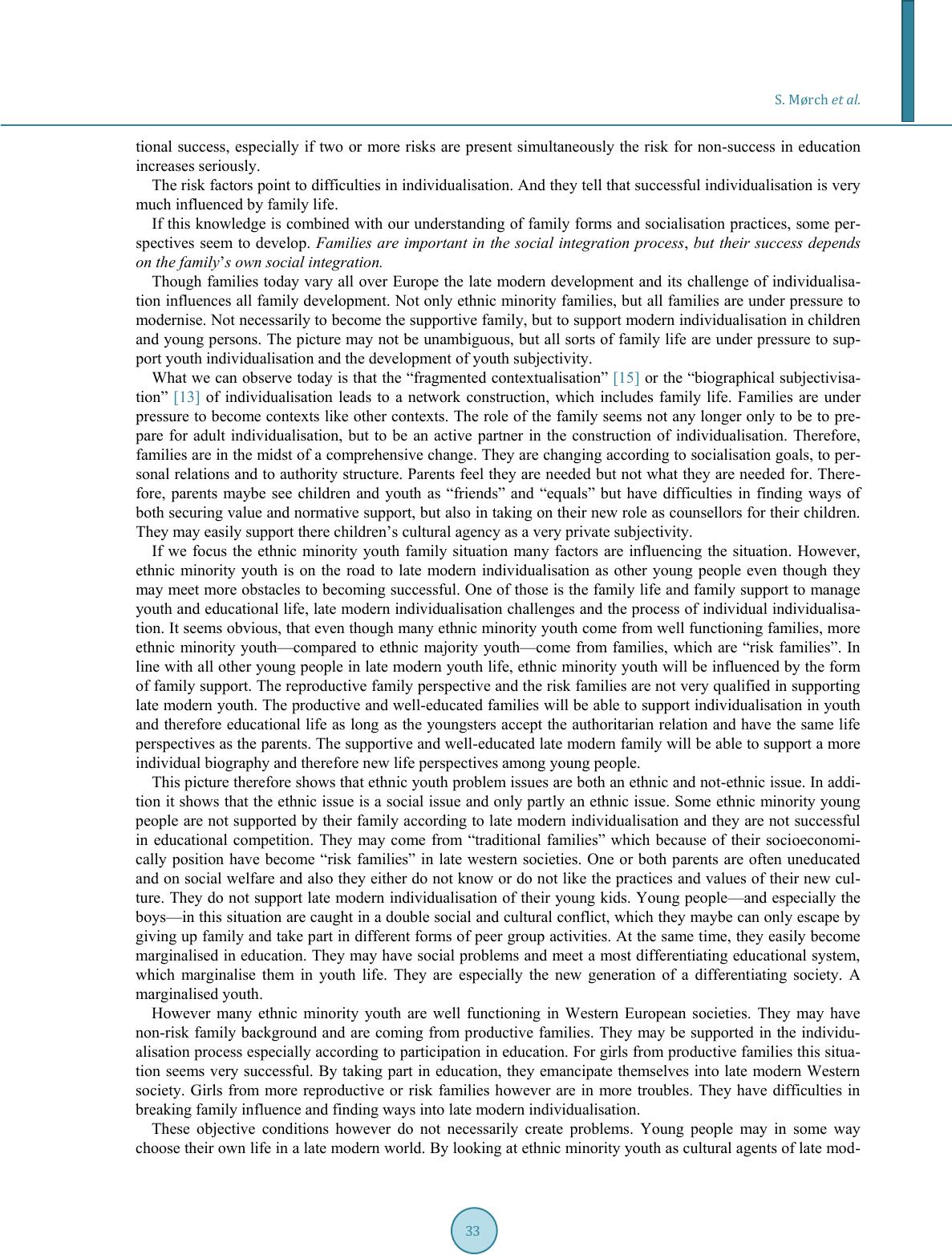 S. Mørch et al. tional success, especially if two or more risks are present simultaneously the risk for non-success in education increases seriously. The risk factors point to difficulties in individualisatio n. And they tell that successful individualisation is v ery much influenced by family life. If this knowledge is combined with our understanding of family forms and socialisation practices, some per- spectives seem to develop. Families are important in the social integration process, but their success depends on the family’s own social integration. Though families today vary all over Europe the late modern development and its challenge of individualisa- tion influences all family development. No t only ethnic minority families, but all families are under pressure to modernise. Not necessarily to b ecome the supportive family, but to support modern individualisation in children and young persons. The picture may not be unambiguous, but all sorts of family life are under pressure to sup- port youth individualisation and the development of youth subjectivity. What we can observe today is that the “fragmented contextualisation” [15] or the “biographical subjectivisa- tion” [13] of individualisation leads to a network construction, which includes family life. Families are under pressure to become contexts like other contexts. The role of the family seems not any longer only to be to pre- pare for adult individualisation, but to be an active partner in the construction of individualisation. Therefore, families are in the midst of a comprehensive change. They are changing according to socialisation goals, to per- sonal relations and to authority structure. Parents feel they are needed but not what they are needed for. There- fore, parents maybe see children and youth as “friends” and “equals” but have difficulties in finding ways of both securing value and normative support, but also in taking on their new role as counsellors for their children. They may easily support there children’ s cultu ral agency as a very private subjectivity. If we focus the ethnic minority youth family situation many factors are influencing the situation. However, ethnic minority youth is on the road to late modern individualisation as other young people even though they may meet more obstacles to becoming successful. One of those is the family life and family support to manage youth and educational life, late modern individualisation challenges and the process of individual individualisa- tion. It seems obvious, that even though many ethnic minority youth come from well functioning families, more ethnic minority youth—compared to ethnic majority youth—come from families, which are “risk families”. In line with all other young pe ople in late modern youth life, ethnic minority youth will be influenced by the form of family support. The reproductive family perspective and the risk families are not very qualified in supporting late modern youth. The productive and well-educated families will be able to support individualisation in youth and therefore educational life as long as the youngsters accept the authoritarian relation and have the same life perspectives as the parents. The supportive and well-educated late modern family will be ab le to support a more individual biography and therefore new life perspectives among young people. This picture therefore shows that ethnic youth problem issues are both an ethnic and not-ethnic issue. In addi- tion it shows that the ethnic issue is a social issue and only partly an ethnic issue. Some ethnic minority young people are not supported by their family according to late modern individualisation and they are not successful in educational competition. They may come from “traditional families” which because of their socioeconomi- cally position have become “risk families” in late western societies. One or both parents are often uneducated and on social welfare and also they either do not know or do not like the practices and values of their new cul- ture. They do not support late modern individualisation of their young kids. Young people—and especially the boys—in this situation are caught in a double social and cultural conflict, which they maybe can only escape by giving up family and take part in different forms of peer group activities. At the same time, they easily become marginalised in education. They may have social problems and meet a most differentiating educational system, which marginalise them in youth life. They are especially the new generation of a differentiating society. A marginalised youth. However many ethnic minority youth are well functioning in Western European societies. They may have non-risk family background and are coming from productive families. They may be supported in the individu- alisation process esp ecially according to participation in education. For girls from productive families t his situa - tion seems very successful. By taking part in education, they emancipate themselves into late modern Western society. Girls from more reproductive or risk families however are in more troubles. They have difficulties in breaking family influence and finding ways into late modern individualisation. These objective conditions however do not necessarily create problems. Young people may in some way choose their own life in a late modern world. By look ing at ethnic minority youth as cultural ag ents of late mod- 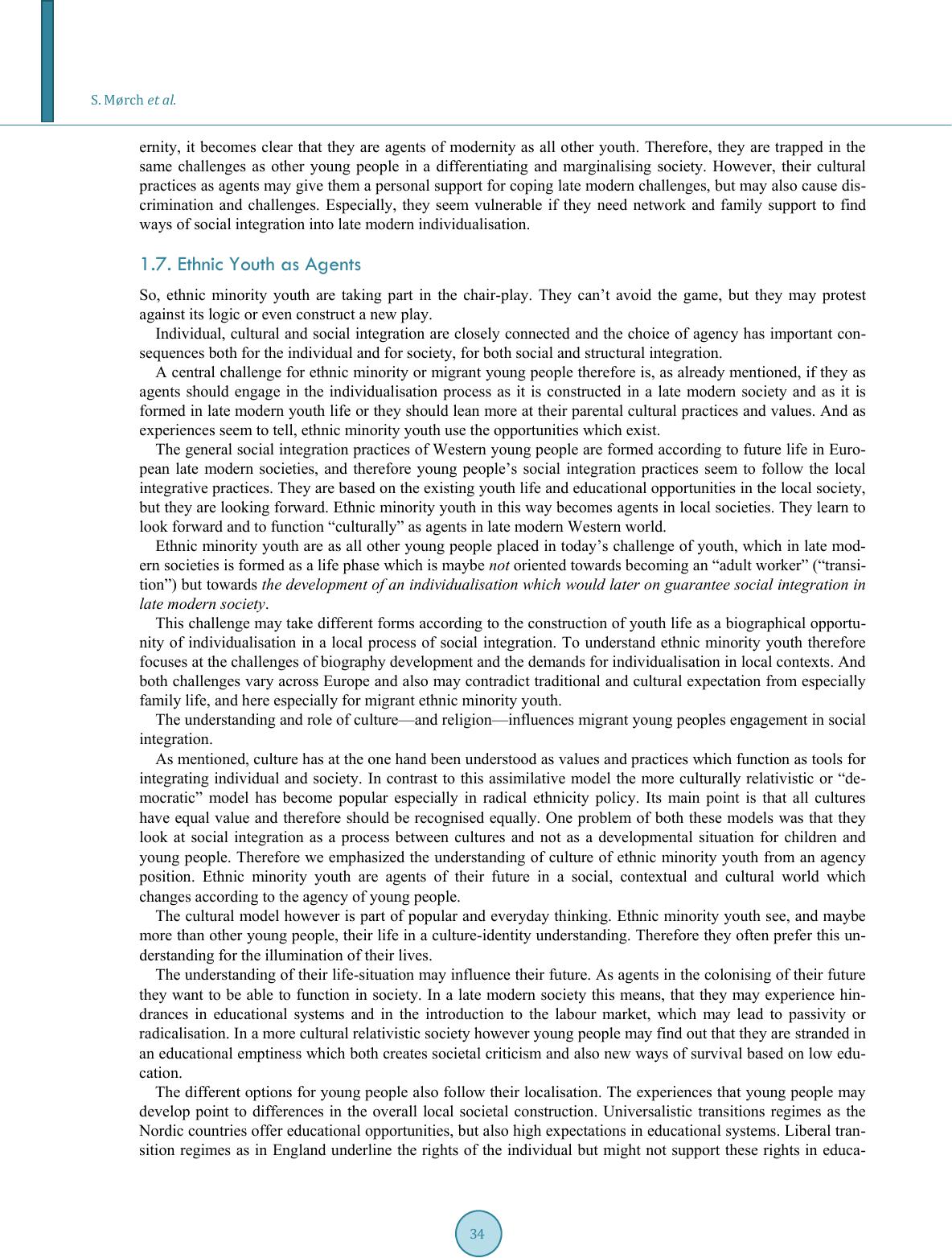 S. Mørch et al. ernity, it becomes clear that they are agents of modernity as all other youth. Therefore, they are trapped in the same challenges as other young people in a differentiating and marginalising society. However, their cultural practices as agents may give them a personal support for coping late modern challenges, but may also cause dis- crimination and challenges. Especially, they seem vulnerable if they need network and family support to find ways of social integration into late modern individua lisation. 1.7. Ethnic Youth as Agents So, ethnic minority youth are taking part in the chair-play. They can’t avoid the game, but they may protest against its logic or even construct a new play. Individual, cultural and social integration are closely connected and the choice of agency has important con- sequences both for the individual and for society, for both social and structural integration. A central challenge for ethnic minority or migrant young people therefore is, as already mentioned, if they as agents should engage in the individualisation process as it is constructed in a late modern society and as it is formed in late modern youth life or they should lean more at their parental cultural practices and values. And as experiences seem to tell, ethnic minority youth use the opportunities which exist. The general social integration practices of Western young people are formed according to future life in Euro- pean late modern societies, and therefore young people’s social integration practices seem to follow the local integrative practices. They are based on the existing youth life and educational opportunities in the local society, but they are looking forward. Ethnic minority youth in this way becomes agents in local societies. They learn to look forward and to functio n “ c ulturall y” as agents in late modern Western world. Ethnic minority youth are as all other young people placed in today’s challenge of youth, which in late mod- ern societies is formed as a life phase which is maybe not oriented towards be coming an “adult worker” (“transi- tion”) but towards the development of an individualisation which would later on guarantee social integration in late modern society. This challenge may take different forms according to the construction of youth life as a biographical opportu- nity of individualisation in a local process of social integration. To understand ethnic minority youth therefore focuses at the challenges of biography development and the demands for individualisation in local contexts. And both challenges vary across Europe and also may contradict traditional and cultural expectation fro m especially family life, and here especially for migrant ethnic minor ity youth. The understanding and role of culture—and religion—influences migrant young peoples engagement in social integration. As mentioned, culture has at the one hand been understood as values and practices which function as tools for integrating individual and society. In contrast to this assimilative model the more culturally relativistic or “de- mocratic” model has become popular especially in radical ethnicity policy. Its main point is that all cultures have equal value and therefore should be recognised equally. One problem of both these models was that they look at social integration as a process between cultures and not as a developmental situation for children and young people. Therefore we emphasized the understanding of culture of ethnic minority youth from an agency position. Ethnic minority youth are agents of their future in a social, contextual and cultural world which changes according to the agency of young people. The cultural model however is part of popular and everyday thinking. Ethnic minority youth see, and maybe more than other young people, their life in a culture-identity understanding. Therefore they often prefer this un - derstanding for the illumination of their lives. The understanding of their life-situation may influence their future. As agents in the colonising of their future they want to be able to function in society. In a late modern society this means, that they may experience hin- drances in educational systems and in the introduction to the labour market, which may lead to passivity or radicalisation. In a more cultural relativistic society however young people may find out that they are stranded in an educational emptiness which both creates societal criticism and also new ways of survival based on low edu- cation. The different options for young people also follow their localisation. The experiences that young people may develop point to differences in the overall local societal construction. Universalistic transitions regimes as the Nordic countries offer educational opportunities, bu t also high expe ctations in educational syste ms. Liberal tran- sition regimes as in England underline the rights of the individual but might not support these rights in educa- 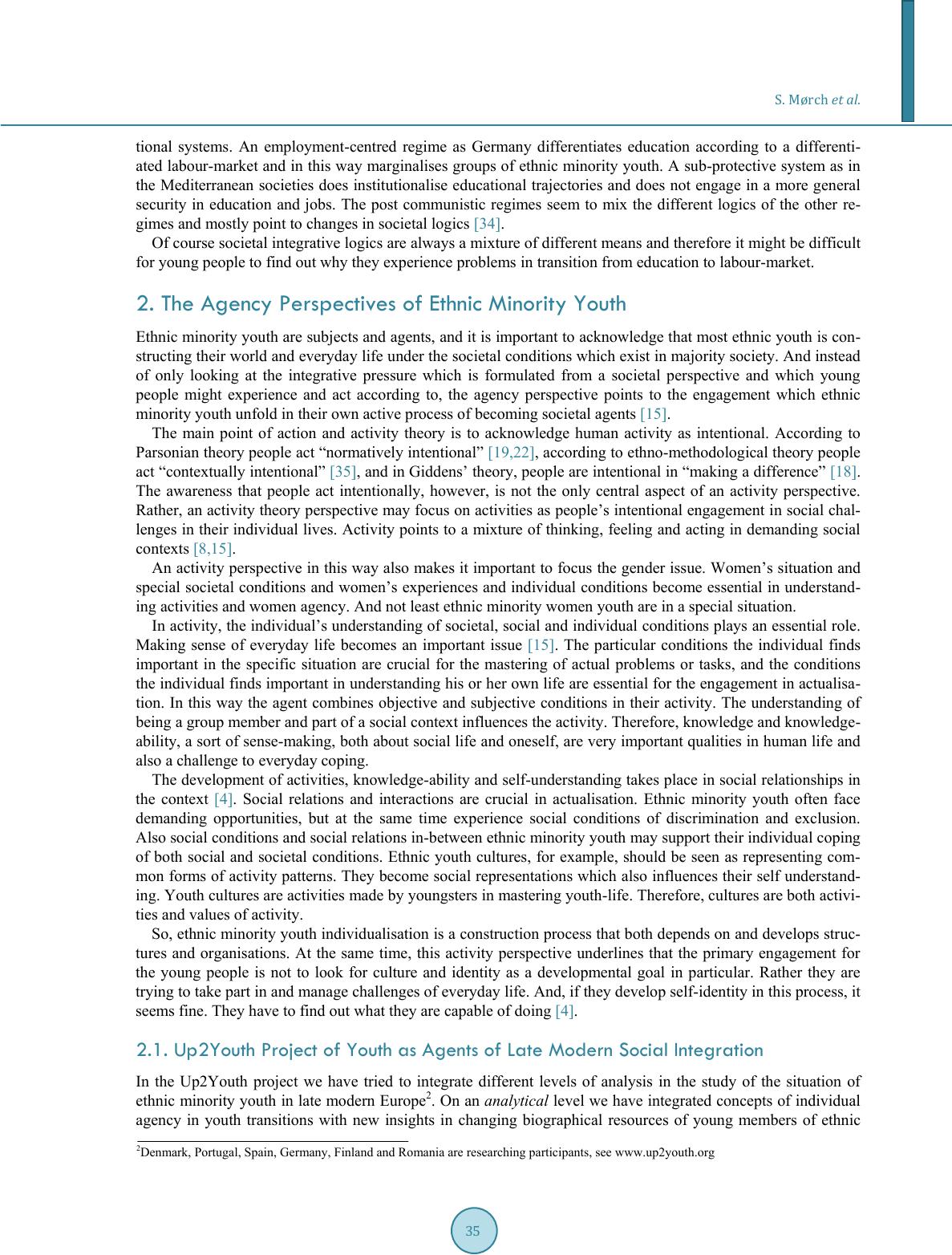 S. Mørch et al. tional systems. An employment-centred regime as Germany differentiates education according to a differenti- ated labour-market and in this way marginalises groups of ethnic minority youth. A sub-protective system as in the Mediterranean societies does institutionalise educational trajectories and does not engage in a more general security in education and jobs. The post communistic regimes seem to mix the different logics of the other re- gimes and mostly point to changes in societal logics [34]. Of course societal integrative logics are always a mixture of different means and therefore it might be difficult for young people to find out why they experience problems in transition from education to labour-market. 2. The Agency Perspectives of Ethnic Minority Youth Ethnic minority youth are subjects and agents, and it is important to acknowledge that most ethnic youth is con- structing their world and everyday life u nder the so cietal conditions wh ich exist in majority society. A nd instead of only looking at the integrative pressure which is formulated from a societal perspective and which young people might experience and act according to, the agency perspective points to the engagement which ethnic minority youth unfold in their own active process of becoming societal agents [15]. The main point of action and activity theory is to acknowledge human activity as intentional. According to Parsonian theory people act “normatively intention al” [19,22], according to ethno-methodological theory people act “con textually intentional” [35], and in Giddens’ theory, people are intentional in “maki ng a d iffe renc e” [18]. The awareness that people act intentionally, however, is not the only central aspect of an activity perspective. Rather, an activity theory perspectiv e may focus on activities as people’s intentional engagement i n social chal- lenges in their individual lives. Activity points to a mixture of thinking, feeling and acting in demanding social contexts [8,15]. An activity perspec tive in this way also makes it important to focus the gender issue. Women’s situation and special societal conditions and women’s experiences and individual conditions become essential in understand- ing activities and women agency. And not least ethnic minority women youth are in a special situation. In activity, the individual’s understanding of societal, social and individual cond itions plays an essential role. Making sense of everyday life becomes an important issue [15]. The particular conditions the individual finds important in the specific situation are crucial for the mastering of actual problems or tasks, and the conditions the individual finds important in understanding his or her own life are essential for the engagement in actualisa- tion. In this way the agent combines objective and subjective conditions in their activity. The understanding of being a group member and part of a social context influences the activity. Therefore, knowledge and knowledge- ability, a sort of sense -making, both about social life and oneself, are very important qualities in human life and also a challenge to everyday coping. The development of activities, knowledge-ability and self-understanding takes place in social relationships in the context [4]. Social relations and interactions are crucial in actualisation. Ethnic minority youth often face demanding opportunities, but at the same time experience social conditions of discrimination and exclusion. Also social conditions and social relations in -between ethnic minority youth may support their individual coping of both social and societal conditions. Ethnic youth cultures, for example, should be seen as representing com- mon forms of activity patterns. They become social representations which also influences their self understand- ing. Youth cultures are activities made by youngsters in mastering youth-life. Therefore, cultures are both activi- ties and values of activity. So, ethnic minority youth individualisation is a construction process that both depends on and develops struc- tures and organisations. At the same time, this activity perspective underlines that the primary engagement for the young people is not to look for culture and identity as a developmental goal in particular. Rather they are trying to take part in and manage challenges of everyday life. And, if they develop self-identity in this process, it seems fine. They have to find out what they are capable of doing [4]. 2.1. Up2Youth Project of Youth as Agents of Late Modern Social Integration In the Up2Youth project we have tried to integrate different levels of analysis in the study of the situation of ethnic minority youth in late modern Europe2. On an analytical level we have integrated concepts of individual agency in youth transitions with new insights in changing biographical resources of young members of ethnic 2Denmark, Portugal, Spain, Germany, Finland and Romania are researching participants, see www.up2youth.org 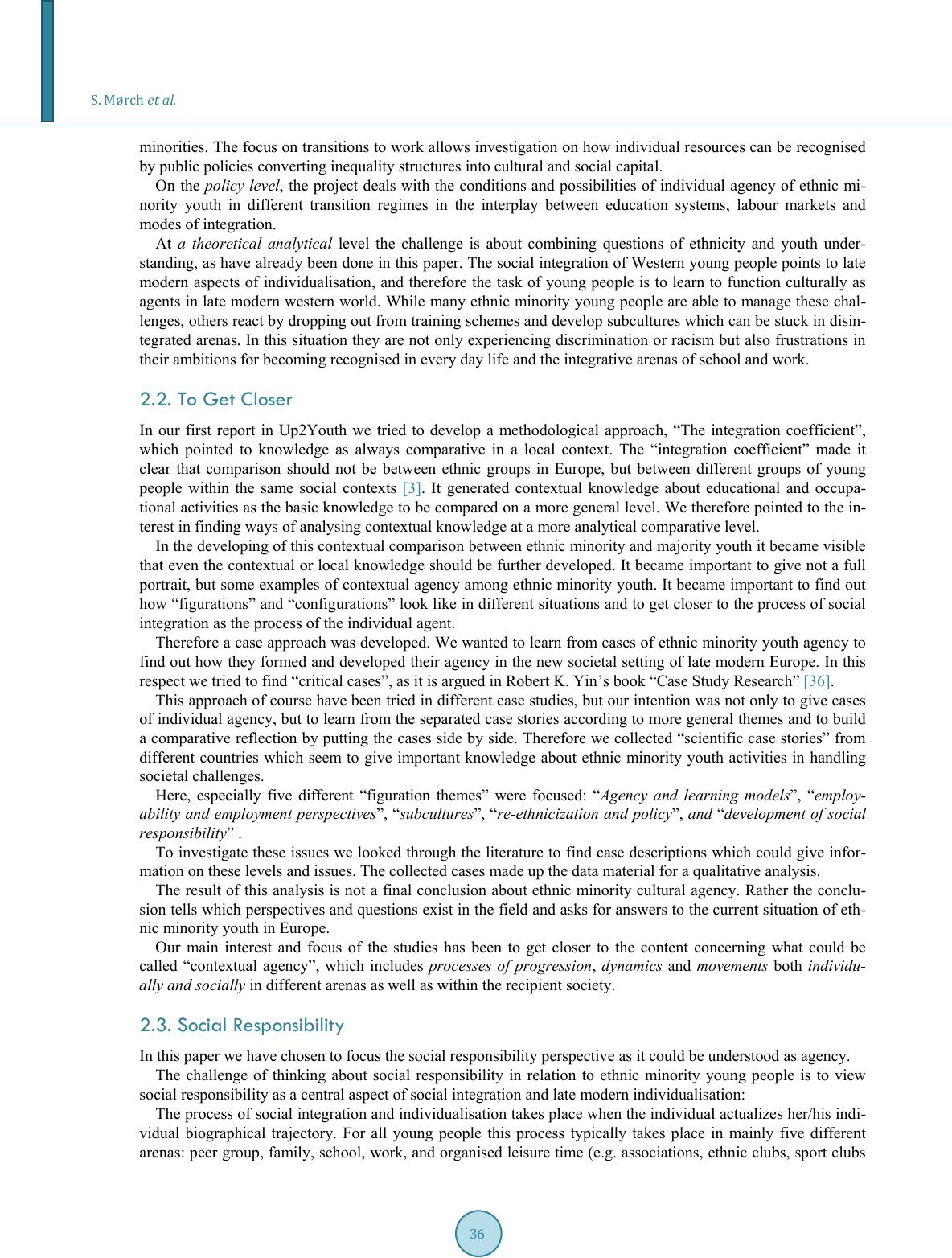 S. Mørch et al. minorities. The focus on transitions to work allows investigation on how individual resources can be recognised by public policies converting inequality structures into cultural and social capital. On the policy level, the project deals with the conditions and possibilities of individual agency of ethnic mi- nority youth in different transition regimes in the interplay between education systems, labour markets and modes of integration. At a theoretical analytical level the challenge is about combining questions of ethnicity and youth under- standing, as have already been done in this paper. The social integration of Western young people points to late modern aspects of individualisation, and therefore the task of young people is to learn to function culturally as agents in late modern western world. While many ethnic minority young people are able to manage these chal- lenges, others react by dropping out from training schemes and develop subcultures which can be stuck in disin- tegrated arenas. In this situation they are not only experiencing discrimination or racism but also frustrations in their ambitions for becoming recognised in every day life and the integrative arenas of school and work. 2.2. To Get Closer In our first report in Up2Youth we tried to develop a methodological approach, “The integration coefficient”, which pointed to knowledge as always comparative in a local context. The “integration coefficient” made it clear that comparison should not be between ethnic groups in Europe, but between different groups of young people within the same social contexts [3]. It generated contextual knowledge about educational and occupa- tional activities as the basic knowledge to be compared on a more general level. We therefore pointed to the in- terest in finding ways of analysing contextual knowledge at a more analytical comparative level. In the developing of this contextual comparison between ethnic minority and majority youth it became visible that even the contextual or local knowledge should be further developed. It became important to give not a full portrait, but some examples of contextual agency among ethnic minority youth. It became important to find out how “figuration s” and “configurations” look like in different situations and to get closer to the process of social integration as the process of the individual agent. Therefore a case approach was developed. We wanted to learn from cases of ethnic minority youth agency to find out how they formed and developed their agency in the new societal setting of late modern Europe. In this respect we tried to find “critical cases”, as it is argued in Robert K. Yin’s book “Case Study Research” [36]. This approach of course have been tried in different case studies, but our intention was not only to give cases of individual agency, but to learn from the separated case stories according to more general themes and to build a comparative reflection by putting the cases side by side. Therefore we collected “scientific case stories” from different countries which seem to give important knowledge about ethnic minority youth activities in handling societal challenges. Here, especially five different “figuration themes” were focused: “Agency and learning models”, “employ- ability and employment perspectives”, “subcultures”, “re-ethnicization and policy”, and “development of social responsibility” . To investigate these issues we looked through the literature to find case descriptions which could give infor- mation on these levels and issues. The collected cases made up the data material for a qualitative analysis. The result of this analysis is not a final conclusion about ethnic minority cultural agency. Rather the conclu- sion tells which perspectives and questions exist in the field and asks for answers to the current situation of eth- nic minority youth in Europe. Our main interest and focus of the studies has been to get closer to the content concerning what could be called “contextual agency”, which includes processes of progression, dynamics and mo vem ents both individu- ally and socially in different arenas as well as within the recipient society. 2.3. Social Responsibility In this paper we have chosen to focus the social responsibility perspective as it could be understood as agency. The challenge of thinking about social responsibility in relation to ethnic minority young people is to view social responsibility as a central aspec t of social integ ration and late modern individualisation: The process of social integration and individualisation takes place when the individual actualizes her/his indi- vidual biographical trajectory. For all young people this process typically takes place in mainly five different arenas: peer group, family, school, work, and organised leisure time (e.g. associations, ethnic clubs, sport clubs 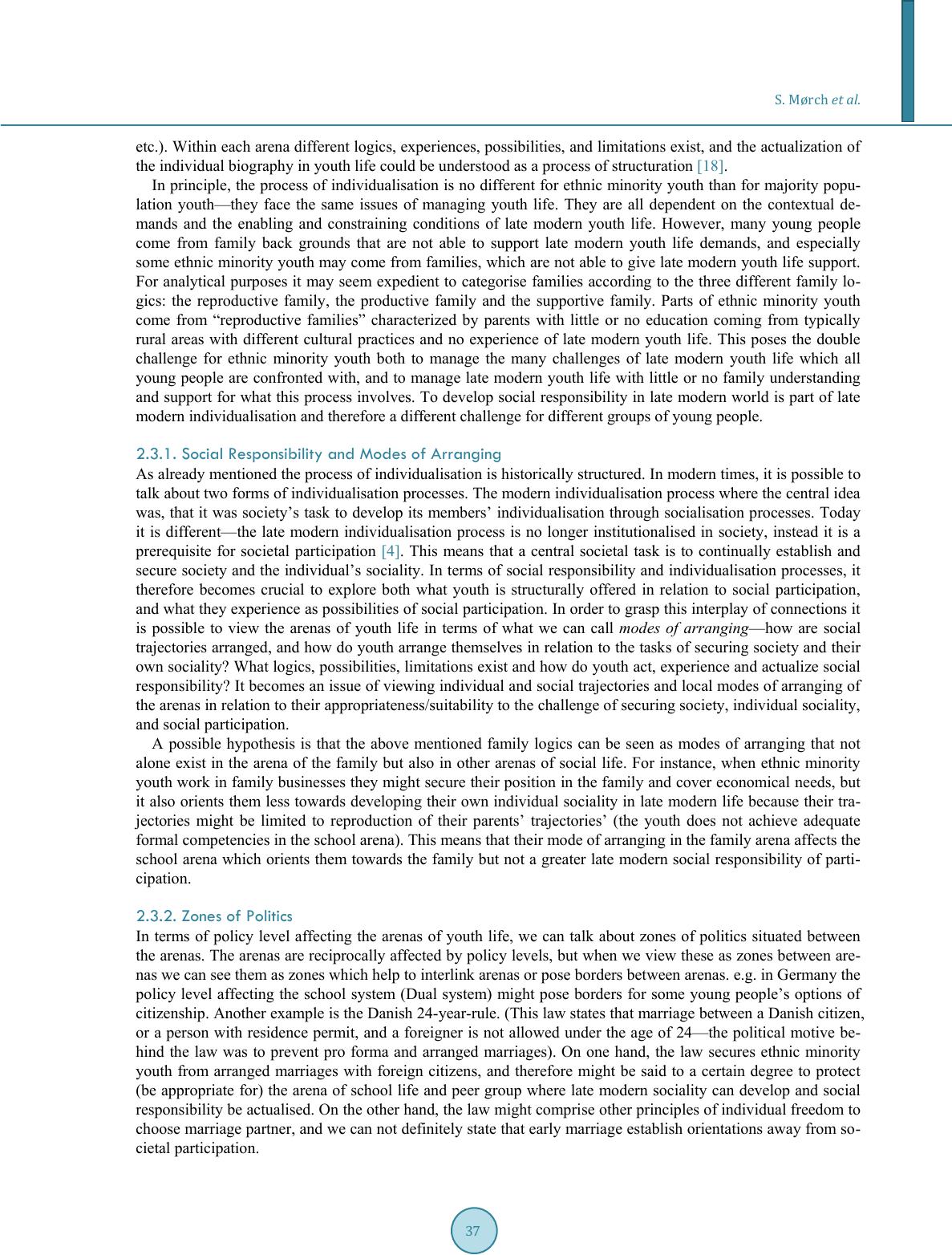 S. Mørch et al. etc.). Within each arena different logics, experiences, possibilities, and limitation s exist, and the actualization of the individual bi ography in youth li fe c ould be understood as a proce s s o f s t ruc turation [18]. In principle, the process of individualisation is no different for ethnic minority youth than for majority popu- lation youth—they face the same issues of managing youth life. They are all dependent on the contextual de- mands and the enabling and constraining conditions of late modern youth life. However, many young people come from family back grounds that are not able to support late modern youth life demands, and especially some ethnic minority youth may come from families, which ar e not able to give late modern youth life support. For analytical purposes it may seem expedient to categorise families according to the three different family lo- gics: the reproductive family, the productive family and the supportive family. Parts of ethnic minority youth come from “reproductive families” characterized by parents with little or no education coming from typically rural areas with different cultural practices and no experience of late modern youth life. This poses the double challenge for ethnic minority youth both to manage the many challenges of late modern youth life which all young people are confronted with, and to manage late modern youth life with little or no family understanding and support for what this process involves. To develop social responsibility in late modern world is part of late modern individualisation and therefore a different challenge for different groups of young people. 2.3.1. Social Responsibility and Modes of Arranging As already mentioned the process of individualisation is historically structured. In modern times, it is possible t o talk about two forms of individualisation processes. The modern individualisation process where the central idea was, that it was society’s task to develop its members’ individualisation through socialisation processes. Today it is different—the late modern individualisation process is no longer institutionalised in society, instead it is a prerequisite for societal participation [4]. This means that a central societal task is to continually establish and secure society and the individual’s sociality. In terms of social responsibility and individualisation processes, it therefore becomes crucial to explore both what youth is structurally offered in relation to social participation, and what they experience as possibilities of social participation . In order to grasp this interplay of connections it is possible to view the arenas of youth life in terms of what we can call modes of arranging—how are social trajectories arranged, and how do youth arrange themselves in relation to the tasks of securing society and their own sociality? What logics, pos sibilities, limitations exist and how do youth act, experience and actualize s ocial responsibility? It becomes an issue of viewing individual and social trajectories and local modes of arranging of the arenas in relation to their appropriaten ess /suitability to the ch allenge of secur ing society, individu al sociality, and social participation. A possible hypothesis is that the above mentioned family logics can be seen as modes of arranging that not alone exist in the arena of the family but also in other arenas of social life. For instance, when ethnic minority youth work in family businesses they might secure their position in the family and cover economical needs, but it also orients them less towards developing their own individual sociality in late modern life because their tra- jectories might be limited to reproduction of their parents’ trajectories’ (the youth does not achieve adequate formal competencies in the school arena). This means that their mode of arranging in the family arena affects the school arena which orients them towards the family but not a greater late modern social responsibility of parti- cipation. 2.3.2. Zones of Politics In terms of policy level affecting the arenas of youth life, we can talk about zones of politics situated between the arenas. The arenas are reciprocally affected by policy levels, but when we view these as zones between are- nas we can see them as zones which help to interlink arenas or pose borders between ar en a s . e.g. in Germany the policy level affecting the school system (Dual system) might pose borders for some young people’s options of citizenship. Another example is the Danish 24-year-rule. (This law states that marriage between a Danish citizen, or a person with residence permit, and a foreigner is not allowed under the age of 24—the political motive be- hind the law was to prevent pro forma and arranged marriages). On one hand, the law secures ethnic minority youth from arranged marriages with foreign citizens, and therefore might be said to a certain degree to protect (be appropriate for) the arena of school life and peer group where late modern sociality can develop and social responsibility be actualised. On the other hand, the law might comprise other principles of individual freedom to choose marriage partner, and we can not definitely state that early marriage establish orientations away from so- cietal participation. 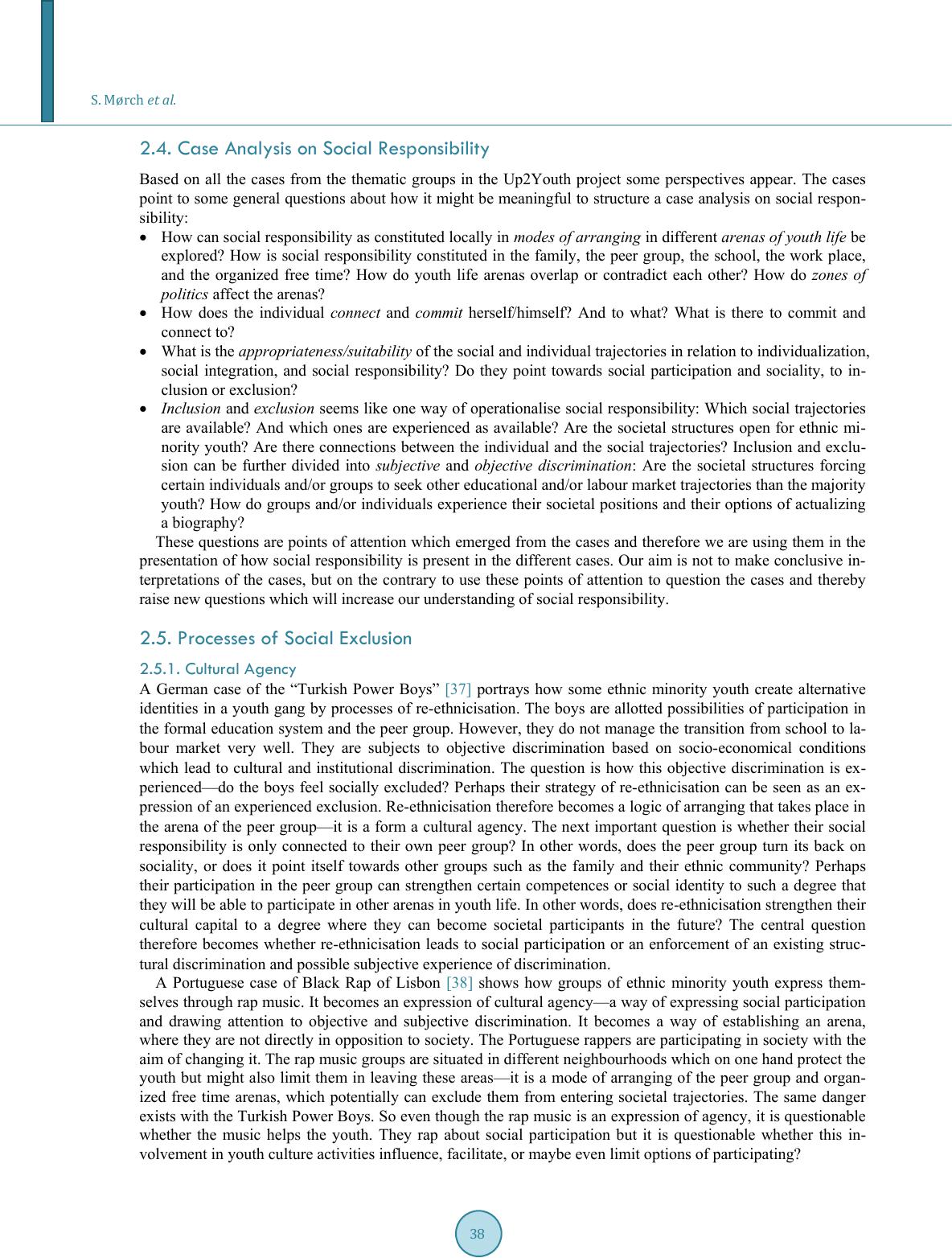 S. Mørch et al. 2.4. Case Analysis on Social Responsibility Based on all the cases from the thematic groups in the Up2Youth project some perspectives appear. The cases point to some general questions about how it might be meaningful to structure a case analysis on social respon- sibility: • How can social responsibility as constituted locally in modes o f a rrang ing in different arenas of youth life be explored? How is social responsibility constituted in the family, the peer group, the school, the work place, and the organized free time? How do youth life arenas overlap or contradict each other? How do zones of politics affect the arenas? • How does the individual connect and comm it herself/himself? And to what? What is there to commit and connect to? • What is the appropriaten es s /suitability o f the social and individual trajectories in relation to individualization, social integration, and social responsibility? Do they point towards social participation and sociality, to in- clusio n or e xc lusio n? • Inclusion and exclusion seems like one way of operationalise social r esponsibility: Which social trajectories are available? And which ones are experienced as available? Are the societal structures open for ethnic mi- nority youth? Are there connections between the individual and the social trajectories? Inclusion and exclu- sion can be further divided into subjective and objective discrimination: Are the societal structures forcing certain individuals and/or groups to seek other educational and/or labour market trajectories than the majority youth? How do groups and/or individuals experience their societal positions and their options of actualizing a biography? These questions are points of attention which emerged from the cases and therefore we are using them in the presentation of how social re sponsibility is present in the different cases. Our aim is not to make conclusive in- terpretations of the cases, but on the contrary to use these points of attention to question the cases and thereby raise new questions whic h will inc re a s e our unders tanding of social responsibility. 2.5. Processes of Social Exclusion 2.5.1. Cultural Agency A German case of the “Turkish Power Boys” [37] portrays how some ethnic minority youth create alternative identities in a youth gang by processes of re-ethnicisation. The boys are allotted possibilities of participation in the formal education system and the peer group. However, they do not manage the transition from school to la- bour market very well. They are subjects to objective discrimination based on socio-economical conditions which lead to cultural and institutional discrimination. The question is how this objective discrimination is ex- perienced—do the boys feel socially excluded? Perhaps their strategy of re-ethnicisation can be seen as an ex- pression of an experienced exclusion. Re-ethnicisation therefore becomes a logic of arranging that takes place in the arena of the peer group—it is a form a cultural agency. The next important question is whether their social responsibility is only connected to their own peer group? In other words, does the peer group turn its back on sociality, or does it point itself towards other groups such as the family and their ethnic community? Perhaps their participation in the peer group can strengthen certain competences or social identity to such a degree that they will be able to participate in other arenas in youth life. In other words, does re-ethnicisation strengthen their cultural capital to a degree where they can become societal participants in the future? The central question therefore becomes whether re-ethnicisation leads to social participation or an enforcement of an existing struc- tural discrimination and possible subjective expe rience of di s c rimi na t ion. A Portuguese case of Black Rap of Lisbon [38] shows how groups of ethnic minority youth express them- selves through rap music. It becomes an expression of cultural agency—a way of expressing social participation and drawing attention to objective and subjective discrimination. It becomes a way of establishing an arena, where they are not directly in opposition to society. The Portuguese rappers are participating in society with the aim of changing it. The rap music groups are situated in different neighbourhoods which on one hand protect the youth but might also limit them in leaving these areas—it is a mode of arranging of the peer group and organ- ized free time arenas, which potentially can exclude them from entering societal trajectories. The same danger exists with the Turkish Power Boys. So even though the rap music is an expression of agency, it is questionable whether the music helps the youth. They rap about social participation but it is questionable whether this in- volvement in youth culture activities influence, f a cilitate, or maybe eve n li mit op tion s of particip a ting? 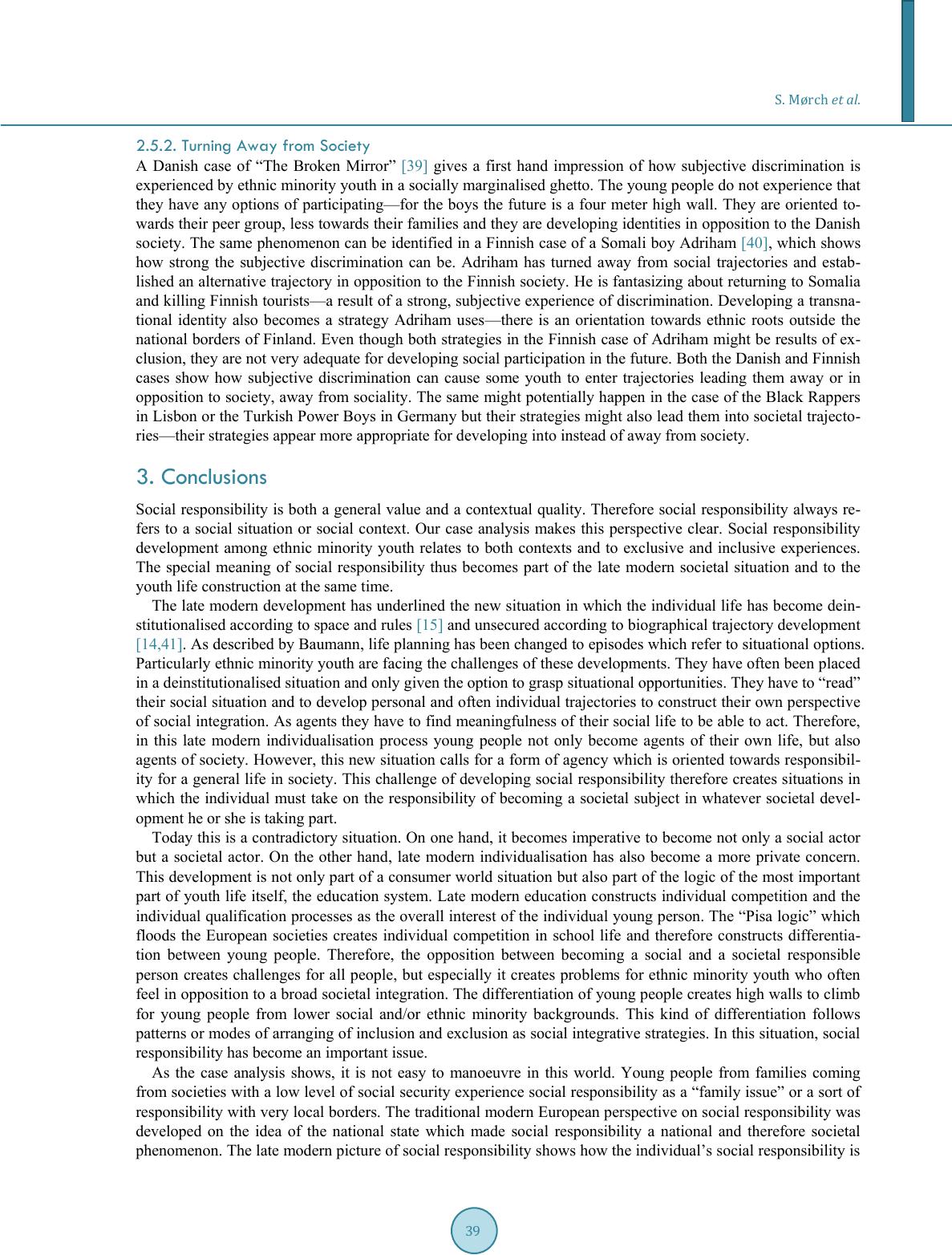 S. Mørch et al. 2.5.2. Turning Away from Society A Danish case of “The Broken Mirror” [39] gives a first hand impression of how subjective discrimination is experienced by ethnic minority youth in a socially marginalised ghetto. The young people do not experience that they have any options of participating—for the boys the future is a four meter high wall. They are oriented to- wards their peer group, less towards their families and they are developing identities in opposition to the Danish society. The same phenomenon can be identified in a Finnish case of a Somali boy Adriham [40], which shows how strong the subjective discrimination can be. Adriham has turned away from social trajectories and estab- lished an alternative trajectory in oppo sition to the Finnish society. He is fantasizing about re turning to Somalia and killing Finnish tourists—a result of a strong, subjective experience of discrimination. Developing a transna- tional identity also becomes a strategy Adriham uses—there is an orientation towards ethnic roots outside the national borders of Finland. Even though both strategies in the Finnish case of Adriham might be results of ex- clusion, they are not very adequate for developing social participation in the future. Both the Danish and Finnish cases show how subjective discrimination can cause some youth to enter trajectories leading them away or in opposition to society, away from sociality. The same might potentially happ en in the case of the Black Rappers in Lisbon or the Turkish Power Boys in Germany but their strateg ies might also lead them into societal trajecto- ries—their strategies appear more appropriate for developing into instead of away from society. 3. Conclusions Social responsibility is both a general value and a contextual quality. Therefore social responsibility always re- fers to a social situation or social context. Our case analysis makes this perspective clear. Social responsibility development among ethnic minority youth relates to both contexts and to exclusive and inclusive experiences. The special meaning of social responsibility thus becomes part of the late modern societal situation and to the youth life construction at the same time. The late modern development has underlined the new situation in which the individual life has become dein- stitutionalised according to space and rules [15] and unsecured according to biogr aph ical tr aj ector y d evelop ment [14,41]. As described by Baumann, life planning has been changed to episodes which refer to situational options. Particularly ethnic minority youth are facing the challenges of these developments. They have often been placed in a deinstitutionalised situ ation and only given the option to grasp situational oppo rtunities. They have to “read” their social situation and to develop personal and often individual trajectories to construct their own perspective of social integration. As agents they have to find meaningfulness of their social life to be able to act. Therefore, in this late modern individualisation process young people not only become agents of their own life, but also agents of society. However, this new situation calls for a form of agency which is oriented towards responsibil- ity for a general life in society. This challenge of developing social resp onsibility therefore creates situations in which the individual must take on the responsibility of becoming a societal subject in whatever societal devel- opment he or she is taking part. Today this is a contradictory situatio n. On one hand, it becomes imperative to become not only a social actor but a societal actor. On the other hand, late modern individualisation has also become a more private concern. This development is not only part of a consumer world situation but also part of the logic of the most important part of youth life itself, the education system. Late modern education constructs individual competition and the individual qualification processes as the overall interest of the individual young person. The “Pisa logic” which floods the European societies creates individual competition in school life and therefore constructs differentia- tion between young people. Therefore, the opposition between becoming a social and a societal responsible person creates challenges for all people, but especially it creates problems for ethnic minority youth who often feel in opposition to a broad societal integration. The differentiation of young people creates high walls to climb for young people from lower social and/or ethnic minority backgrounds. This kind of differentiation follows patterns or modes of arranging of inclusion and exclusion as social integrative strategies. In this situation, social responsibility has become an important issue. As the case analysis shows, it is not easy to manoeuvre in this world. Young people from families coming from societies with a low level of social secur ity experience social responsibility as a “family issue” or a sort of responsibility with very local borders. The traditional modern European perspective on social responsibility was developed on the idea of the national state which made social responsibility a national and therefore societal phenomenon. The late modern picture of social responsib ility shows how the indiv idual’s social responsibility is 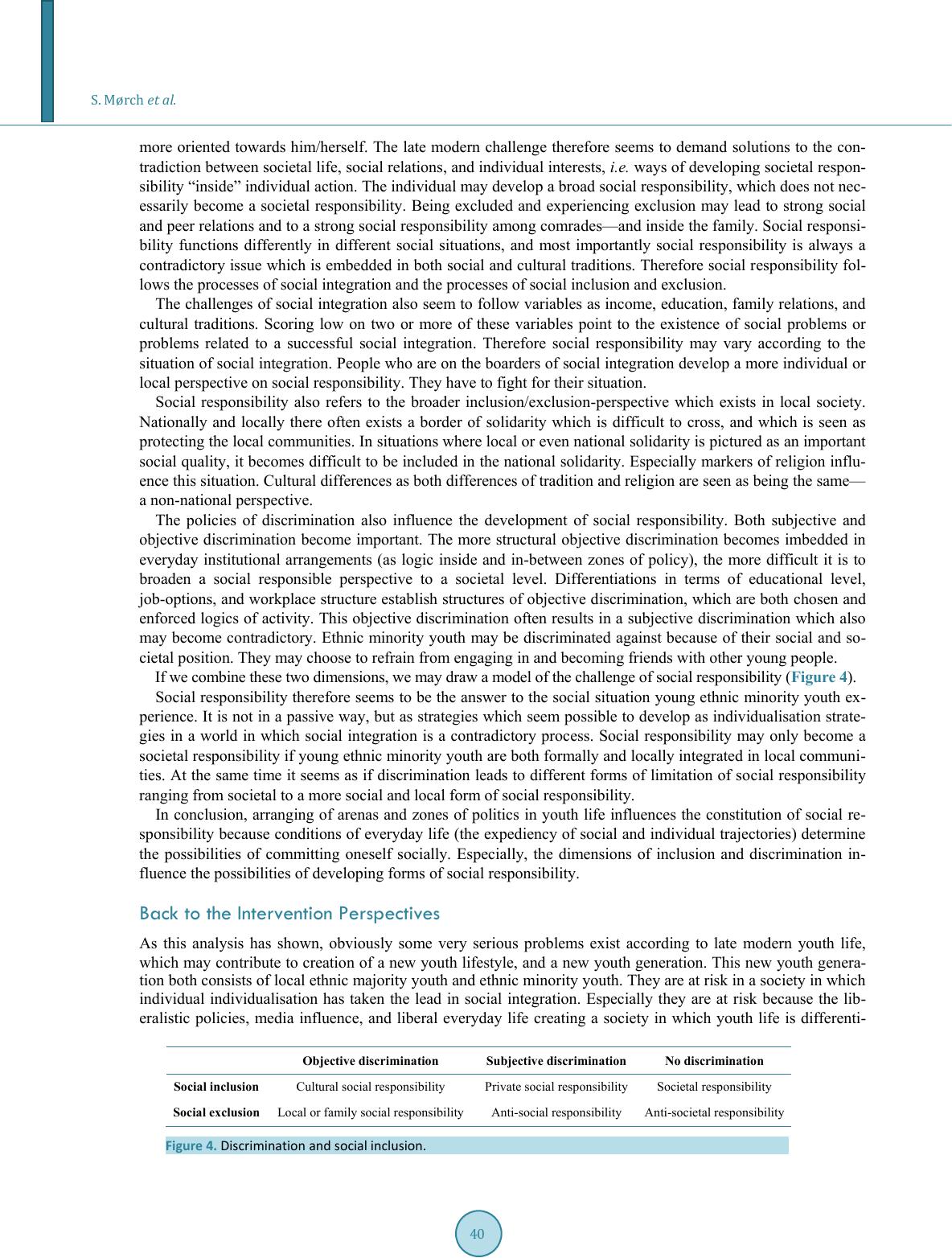 S. Mørch et al. more oriented towards him/herself. The late modern challenge therefore seems to demand solutions to the con- tradiction between societal life, so cial relations, and indiv idual interests, i.e. ways of developing societal respon- sibility “inside” individual action. The individual may develop a broad social responsibility, which does not nec- essarily become a societal responsibility. Being excluded and experiencing exclusion may lead to strong social and peer relations and to a strong social responsibility among comrades—and inside the family. Social responsi- bility functions differently in different social situations, and most importantly social responsibility is always a contradictory issue which is embedded in both social and cultural traditions. Therefore social responsibility fol - lows the processes of social integration and the processes of social inclusion and exclusion. The challenges of social integration also seem to follow variables as income, education, family relations, and cultural traditions. Scoring low on two or more of these variables point to the existence of social problems or problems related to a successful social integration. Therefore social responsibility may vary according to the situation of social inte gration. People who are on the bo arders of social integr ation develop a more individual or local perspective on social responsibility. Th ey have to fight for their situation. Social responsibility also refers to the broader inclusion/exclusion-perspective which exists in local society. Nationally and locally there often exists a border of solidarity which is difficult to cross, and which is seen as protecting the local communities. In situations where local or even national solidarity is pictured as an important social quality, it becomes difficu lt to be included in the national solidarity. Especially markers of religion influ- ence this situation. Cultural differences as both differences of tradition and religion are seen as being the same— a non-national perspective. The policies of discrimination also influence the development of social responsibility. Both subjective and objective discrimination become important. The more structural objective discrimination becomes imbedded in everyday institutional arrangements (as logic inside and in-between zones of policy), the more difficult it is to broaden a social responsible perspective to a societal level. Differentiations in terms of educational level, job-options, and workplace structure establish structures of objective discrimination, which are both chosen an d enforced logics of activity. This objective discrimination often results in a subjective discrimination which also may become contradictory. Ethnic minority youth may be discriminated against because of their social and so- cietal position. They may choose to refrain from engaging in and becoming friends with other young people. If we combi ne the se two dim ensi ons, we m ay draw a m odel of the chall enge of soc ial res ponsibili ty (Figure 4). Social responsibility theref ore seems to be the answer to the social situatio n young ethnic minority youth ex- perience. It is not in a passive way, but as strategies which seem possible to develop as individualisation strate- gies in a world in which social integration is a contradictory process. Social responsibility may only become a societal responsibility if young ethnic minority youth are both formally and locally integrated in local communi- ties. At the same time it seems as if discrimination leads to different forms of limitation of so cial responsibility ranging from societal to a more social and local form of social responsibility. In conclusion, arranging of arenas and zones of politics in youth life influences the constitution of social re- sponsibility because conditions of everyday life (the expediency of social and individual trajectories) determine the possibilities of committing oneself socially. Especially, the dimensions of inclusion and discrimination in- fluence the possibilities of developing forms of soc ial r esp onsibility. Back to the Intervention Perspectives As this analysis has shown, obviously some very serious problems exist according to late modern youth life, which may contribute to creation of a new youth lifestyle, and a new youth generation. This new youth genera- tion both consists of local ethnic majority youth and ethnic minority youth. They are at risk in a society in which individual individualisation has taken the lead in social integration. Especially they are at risk because the lib- eralistic policies, media influence, and liberal everyday life creating a society in which youth life is differenti- Objective discrimination Subjective discrimination No discrimination Social inclusion Cultural social responsibility Private social responsibility Societal responsibility Social exclusion Local or family social responsibility Anti-social responsibility Anti-societal responsibility Figure 4. Discrimination and social inclusion. 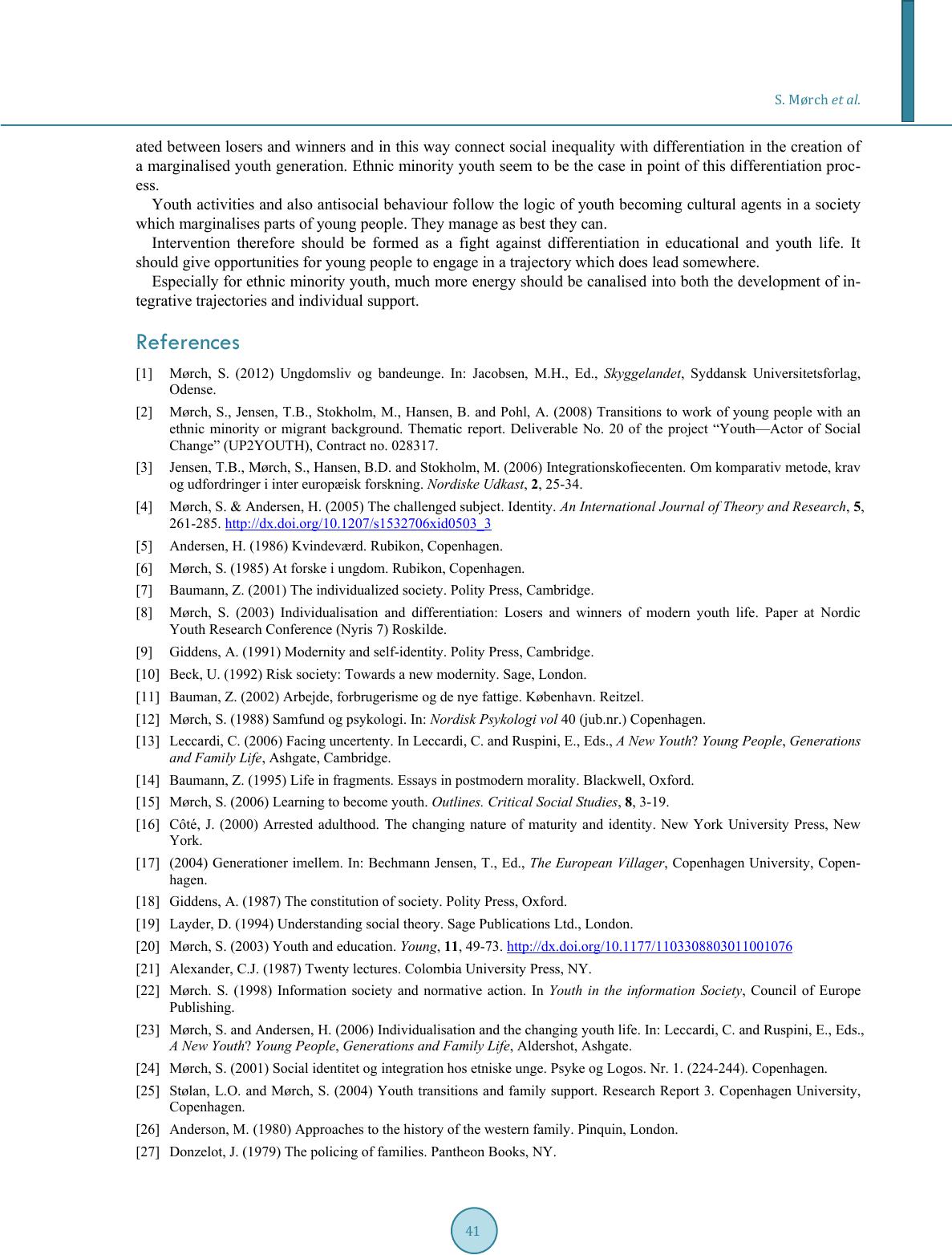 S. Mørch et al. ated between losers and winners and in this way connect social inequality with differentiation in the creation of a marginalised youth generation. Ethnic minority youth seem to be the case in point of this differentiation proc- ess. Youth activities and also antisocial behaviou r follow the logic of youth becoming cultural agents in a society which marginalises parts of young people. They manage as best they can. Intervention therefore should be formed as a fight against differentiation in educational and youth life. It should gi ve o pportunities for young people to engage in a trajectory which does lead somewhere. Especially for ethnic minority youth, much more energy should be canalised into both the development of in- tegrative trajectories and individual suppo rt. References [1] Mørch, S. (2012) Ungdomsliv og bandeunge. In: Jacobsen, M.H., Ed., Skyggelandet, Syddansk Universitetsforlag, Odense. [2] Mørch, S., Jensen, T.B., Stokholm, M., Hansen, B. and Pohl, A. (2008) Transitions to work of young people with an ethnic minority or migrant background. Thematic report. Deliverable No. 20 of the project “Youth—Actor of Social Change” (UP2YOUTH), Contract no. 028317. [3] Jensen, T.B., Mørch, S., Hanse n, B.D. and Stokholm, M. (2006) Integrationskofiecenten. Om komparativ metode, krav og udfordringer i inter europæisk forskning. Nordiske Udkast, 2, 25-34. [4] Mørch, S. & Andersen, H. (2005) The challenged subject. Identity. An International Journal of Theory and Research, 5, 261-285. http://dx.doi.org/10.1207/s1532706xid0503_3 [5] Andersen, H. (1986) Kvindeværd. Rubikon, Copenhagen. [6] Mørch, S. (1985) At forske i ungdom. Rubikon, Copenhagen. [7] Baumann, Z. (2001) The individualized society. Poli ty Press, Cambridge. [8] Mørch, S. (2003) Individualisation and differentiation: Losers and winners of modern youth life. Paper at Nordic Youth Research Conference (Nyris 7) Roskilde. [9] Giddens, A. (1991) Modernity and self-identity. P ol ity Press, Cambridge. [10] Beck, U. (1992) Risk society: Towards a new modernity. Sage, London. [11] Bauman, Z. (2002) Arbejde, forbrugerisme og de nye fattige. København. Reitzel. [12] Mørch, S. (1988) Samfund og psykologi. In: Nordisk Psykologi vol 40 (jub.nr.) Copenhagen. [13] Leccardi, C. (2006) Facing uncertenty. In Leccardi, C. and Ruspini, E., Eds., A New Youth? Young People, Generations and Family L ife, Ashgate, Cambridge. [14] Baumann, Z. (1995) Life in fragments. Essays in postmodern morality. Blackwell, Oxford. [15] Mørch, S. (2006) Learning to become youth. Outlines. Critical Social Studies, 8, 3-19. [16] Côté, J. (2000) Arrested adulthood. The changing nature of maturity and identity. New York University Press, New York. [17] (2004) Generationer imellem. In: Bechmann Jensen, T., Ed., The European Villager, Copenhagen University, Copen- hagen. [18] Giddens, A. (1987) The constitution of society. Polity Press, Oxford. [19] Layder, D. (1994) Understanding social theory. Sage Publications Ltd., London. [20] Mørch, S. (2003) Youth and education. Young, 11, 49-73. http://dx.doi.org/10.1177/1103308803011001076 [21] Alexander, C.J. (1987) Twenty lectures. Colombia University Press, NY. [22] Mørch. S. (1998) Information society and normative action. In Youth in the information Society, Council of Europe Publishing. [23] Mørch, S. and Andersen, H. (2006) Individualisation and the changing youth life. In: Leccardi, C. and Ruspini, E., Eds., A New Youth? Young People, Generations and Family Life, Aldershot, Ashgate. [24] Mørch, S. (2001) Social identitet og integration hos etniske unge. Psyke og Logos. Nr. 1. (224-244). Copenhagen. [25] Stølan, L.O. and Mørch, S. (2004) You th transitions and family support. Research Report 3. Copenhagen University, Copenhagen. [26] Anderson, M. (1980) Approaches to the history of the western family. Pinquin, London. [27] Donzelot, J. (1979) The policing of families. Pantheon Books, NY. 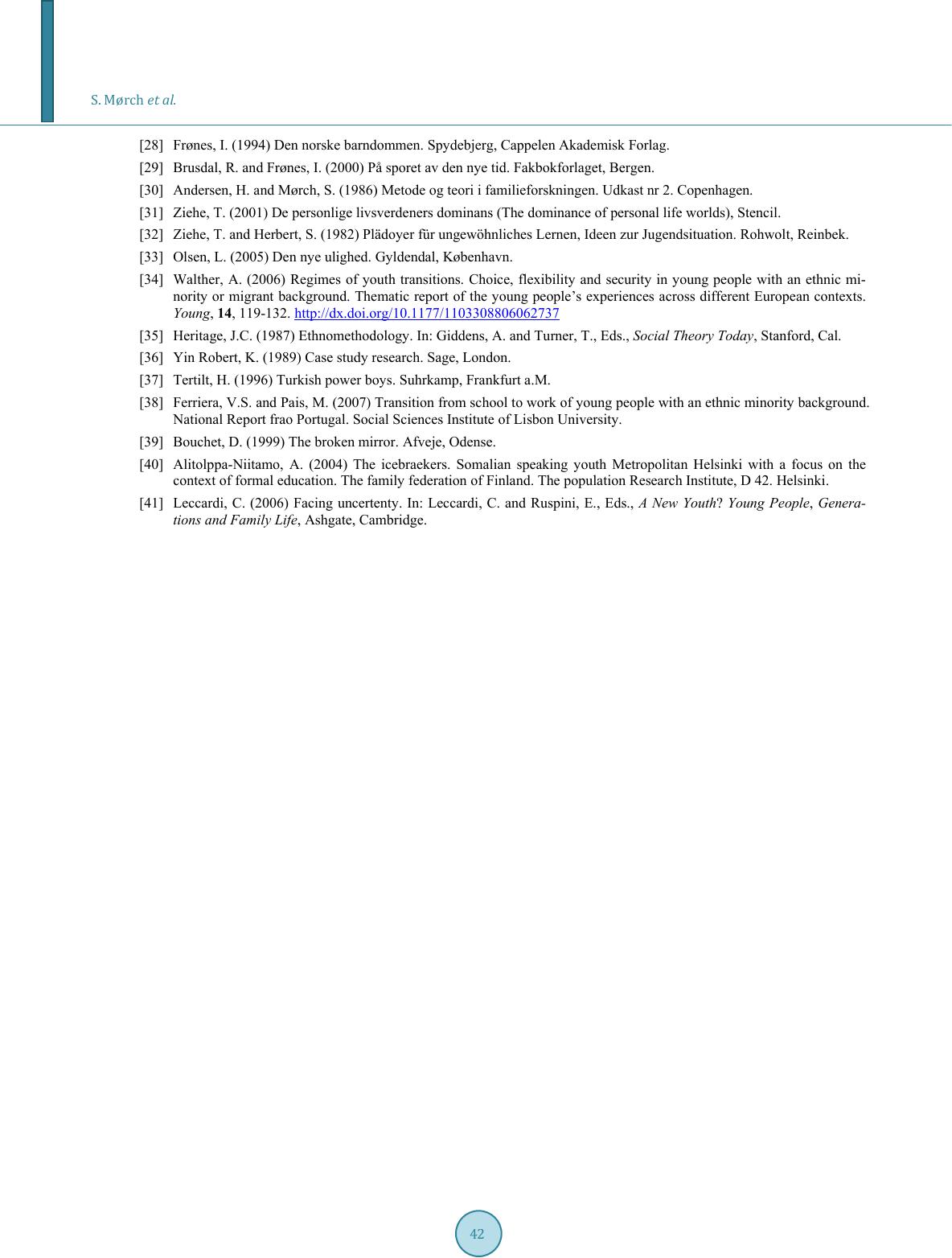 S. Mørch et al. [28] Frønes, I. (1994) Den norske barndommen. Spydebjerg, Cappelen Akademisk Forlag. [29] Brusdal, R. and Frønes, I. (2000) På sporet av den nye tid. Fakbokforlaget, Bergen. [30] Andersen, H. and Mørch, S. (1986) Metode og teori i familieforskningen. Udkast nr 2. Copenhagen. [31] Ziehe, T. (2001) De personlige livsverdeners dominans (The dominance of personal life worlds), Stencil. [32] Ziehe, T. and Herbert, S. (1982) Plädoyer für ungewöhnliches Lernen, Ideen zur Jugendsituation. Rohwolt, Reinbek. [33] Olsen, L. (2005) Den nye ulighed. Gyldendal, København. [34] Walther, A. (2006) Regimes of youth transitions. Choice, flexibility and security in young people with an ethnic mi- nority or migrant background. Thematic report of the young people’s experiences across different European contexts. Young, 14, 119-132. http://dx.doi.org/10.1177/1103308806062737 [35] Heritage, J.C. (1987) Ethnomethodology. In: Giddens, A. and Turner, T., Eds., Social Theory Today, Stanford, Cal. [36] Yin Robert, K. (1989) Case study research. Sage, London. [37] Tertilt, H. (1996) Turkish power boys. Suhrkamp, Frankfurt a.M. [38] Ferriera, V. S. and Pais, M. (2007) Transition from school to work of young people with an ethnic minority background. National Report frao Portugal. Social Sciences Institute of Lisbon University. [39] Bouchet, D. (1999) The broken mirror. Afveje, Odense. [40] Alitolppa-Niitamo, A. (2004) The icebraekers. Somalian speaking youth Metropolitan Helsinki with a focus on the context of formal education. The family federation of Finland. The population Research Institute, D 42. Helsinki. [41] Leccardi, C. (2006) Facing uncertenty. In: Leccardi, C. and Ruspini, E., Eds., A New Youth? Young People, Genera - tions and Family Life, Ashgate, Cambridge.
|